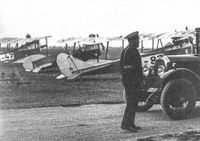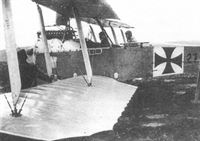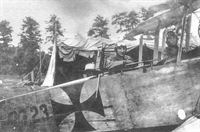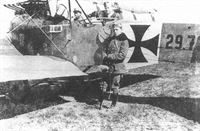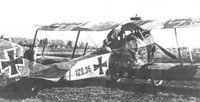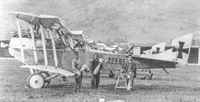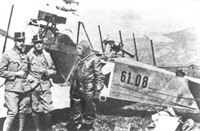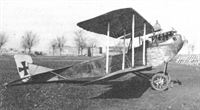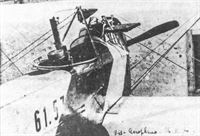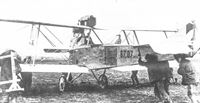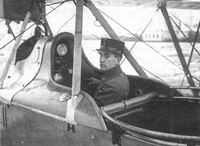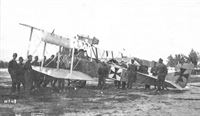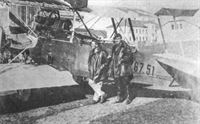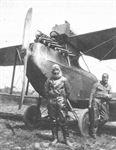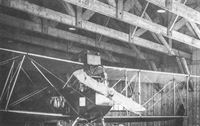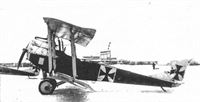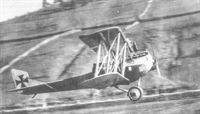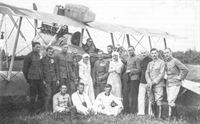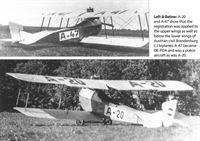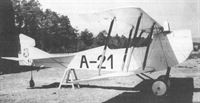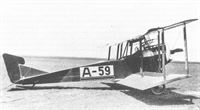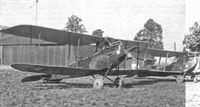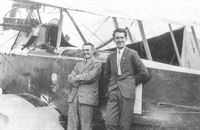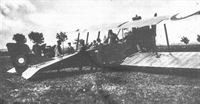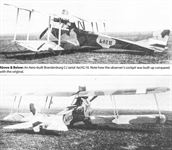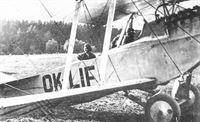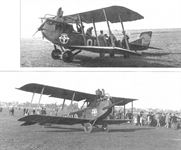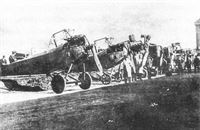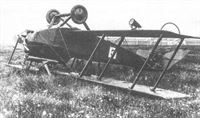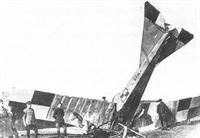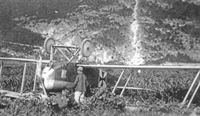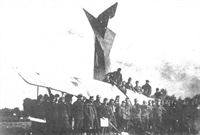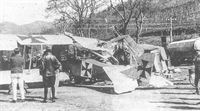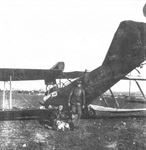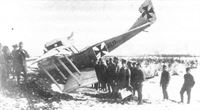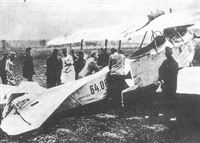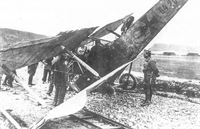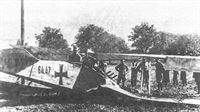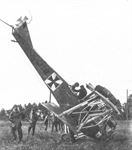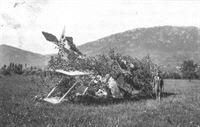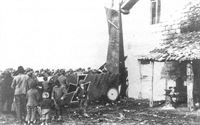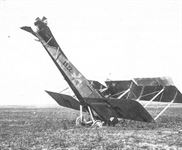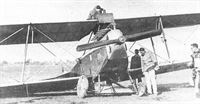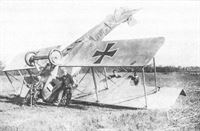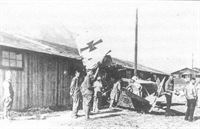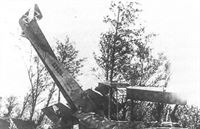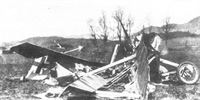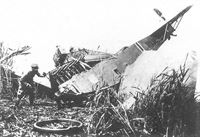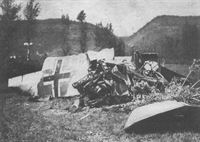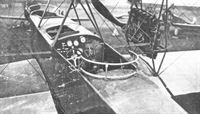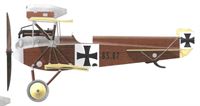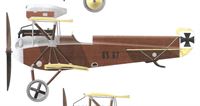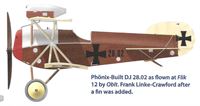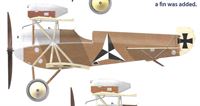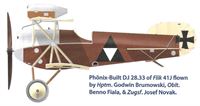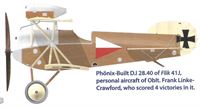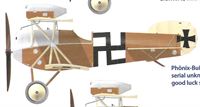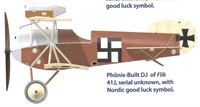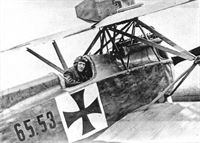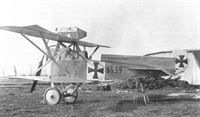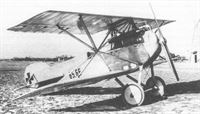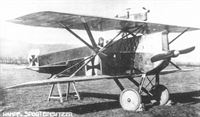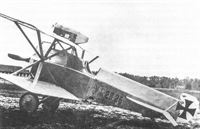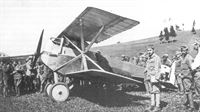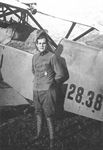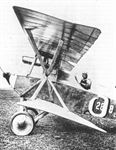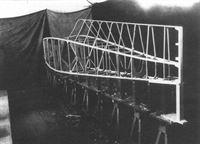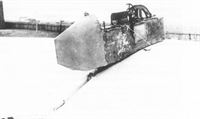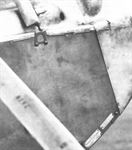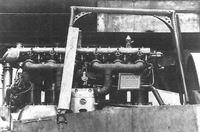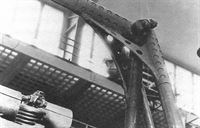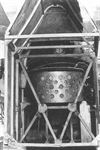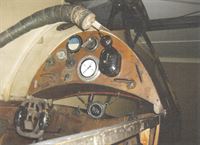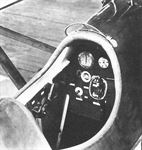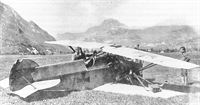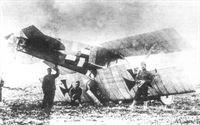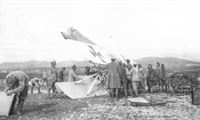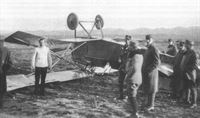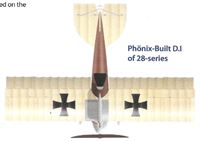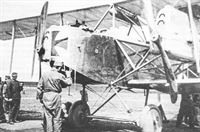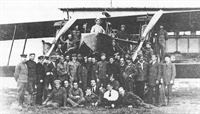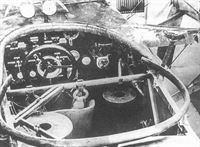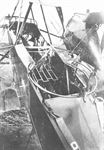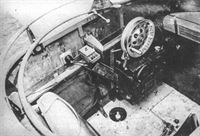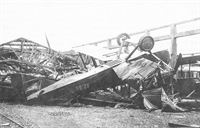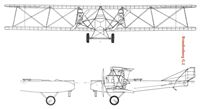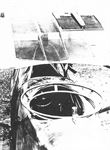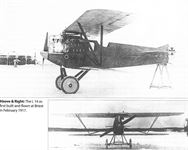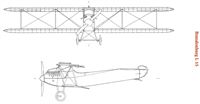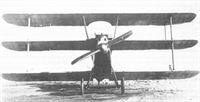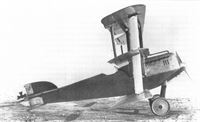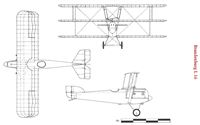Книги
Centennial Perspective
C.Owers
Hansa-Brandenburg Aircraft of WWI. Volume 1 - Landplanes
487
C.Owers - Hansa-Brandenburg Aircraft of WWI. Volume 1 - Landplanes /Centennial Perspective/ (17)
The Oeffag-built Albatros D.III was the preferred fighter of the kuk. Here Albatros fighters are lined up in front of Aviatik Berg D.I fighters (C.I ???) and a lone Brandenburg D.I. The steep terrain was typical of that flown in the Italian front.
Probably taken at a repair depot this photograph depicts three fuselages of the most important Austro-Hungarian types undergoing maintenance/repair work, the Oeffag Albatros D.III, Brandenburg D.I and C.I. All three machines feature wooden frameworks with ply covering giving a strong, robust structure.
The Oeffag-built Albatros D.III was the preferred fighter of the kuk. Here Albatros fighters are lined up in front of Aviatik Berg D.I fighters (C.I ???) and a lone Brandenburg D.I. The steep terrain was typical of that flown in the Italian front.
A Lloyd C-type leads this line up with Brandenburg C.I reconnaissance machines. Note fuselage and wings stored in the canvas hangar. (AHT AL0995-045)
This photograph captured three Austrian civil aircraft together on an airfield: the first aircraft is stated to be a Brandenburg B.I, followed by a Phoenix fighter and a Brandenburg C.I, registration A-47.
The solitary Brandenburg C.I in this lineup of Polish Nieuport and Bristol Fighters has the old rudder markings.
A battered Brandenburg W.12, W.19 or W.29 fuselage lies amongst other wreckage and parts in this hangar at Wilhelmshaven. The wings stacked to the right have the number 2069 stencilled thereon. MN 2069 was a Friedrichshafen FF 49C. (AHT ALAL0225-70)
A typical Norderney winter scene with a Brandenburg FB hiding at the waterline with Gotha WD7 MN 674 at left and Brandenburg NW (Gotha WD12 ???) floatplanes
A typical Norderney winter scene with a Brandenburg FB hiding at the waterline with Gotha WD7 MN 674 at left and Brandenburg NW (Gotha WD12 ???) floatplanes
Brandenburg Type FD (German B.I)
The Type FD was a development of the D with revised tail surfaces. This two-seat reconnaissance aircraft had inward-sloping interplane struts that were to be a feature of future Brandenburg aircraft. The Type FD could have two- or three-bay wings. The FD had a divided tailplane, Albatros fashion, with the fuselage separating the two sections of the tailplane. Brandenburg adopted a horizontal tailplane that was in one piece and rested on top of the fuselage. The Type LDD was the machine given the Austro-Hungarian B.I designation and the existence of two different B.I biplanes has caused confusion in many publications. Gray & Thetford give the designation B.I to the Type FD as does the Typenschau under the entry for the Phonix B.I.
The number of Type FD biplanes purchased by the German Army in 1914 is given as nine, although some sources state only eight. Apparently some of these machines had no military numbers and were probably the property of Brandenburg and were used at the Caspar Flying School at Fuhlsbuttel. (8) However this may be a confusion of the LDD (B.I) biplanes supplied to that school.
Four ex-German Army FD machines were supplied to Austria-Hungary and were given the serials 05.01 to 05.04. The Austro-Hungarian LFT complained that the 05.04 was shoddily built, and this confirms the German Army's experience with Brandenburg products, that service refusing to purchase any more of the company's aircraft. The LFT quartet were refurbished and ended their days as trainers.
(8) These Militar Fliegerschulen were conducted by private firms working under an official Idflieg program. The school was in charge of an officer who made sure that the curriculum was strictly adhered to.The school had to provide board and lodging to the pupils and the course lasted from four to six weeks, although it often took longer due to weather, lack of aircraft, and other factors. For each successful pupil the school received 8,000 marks. Handbook of German Military and Naval Aviation (War) 1914-1918, Originally issued by British Air Ministry, reprint by IWM & Battery Press, 1995.
Brandenburg FD Specifications
Source Typenschau Gray & Thetford Grosz Data 05.01
Span, m 13.12/12.32 13.128 14.50
Length, m 8.20 8.45 9.40
Height, m - 2.96 3.00
Wing Area 43.46 m2 43.45 m2 46 m2
Weight (empty) - - 790 kg
Max Speed - - 90 km/hr
Motor 100-hp Argus 110-hp Benz III 100-hp Mercedes
Note: With the exception of the motor, the Typenschau gives exactly the same dimensions for the Phonix B.I that it states was the FD built under license. The motor is quoted as a 100-hp Austro Daimler. This volume gives the same specifications for the FD, LDD, and DD in the Brandenburg section indicating that these machines are confused in this publication even though it was produced by the Heinkel Company.
Brandenburg Type LDD (Austro-Hungarian B.I)
The Type LDD tractor biplane was the last Brandenburg design of 1914 and placed the pilot in the front cockpit for the first time. The design was refined from the Type FD with wooden engine mounts replacing the steel mount of the FD and further design refinements to the aircraft's structure. The prototype was sent to Austro-Hungary for evaluation and as the performance proved satisfactory it was ordered in large numbers as the B.I (Series 05.1). In addition it was licence built at the Fliegerarsenal Flugzeugwerke at Fischamend (Series 76, 176 and 276). After service as an unarmed reconnaissance aircraft on the Russian and Italian Fronts the type was used as a trainer. Modified to dual control, it was continually refined and was to continue in production for the rest of the war. Post-war small numbers ended up in the air forces of Czechoslovakia, Hungary, Poland and Yugoslavia.
Of the 102 constructed by Brandenburg, 16 were delivered to the Brandenburg flying School near Hamburg. Approximately 400 were constructed by the Austro-Hungarians till 1918.
At least 22 B.I trainers were used by the Czechoslovakian air arm post war. B.I 176.95 was the only aircraft of No.4 Squadron at Plzen in November-December 1918.
The Czechoslovakia firm of Vojenska tovarna na letadla (later Letov) produced a direct copy of the B.I (Fd) as the S.10. This company, originally created by the Ministry of Defence to repair the aircraft, obtained a license to produce the type after the end of the war. Aircraft 176.80 was the pattern aircraft for the series production of the S.10. A total of 51 of these biplanes were manufactured and delivered during 1922-23. The type was very successful and was more popular than its replacement, the S.18 that replaced the type from 1926. They continued in service until the early 1930s and then were sold to aero clubs. Some were still in service when the Germans occupied Czechoslovakia in March 1939.
The Aero Company also produced the Brandenburg B.I and C.I. The B.I was constructed as the Aero A-1 from September 1919 with 35 examples powered by the 100-hp Mercedes motor being produced. The type could be fitted with a balanced or unbalanced rudder. The horizontal tailplane was redesigned to a half-elliptical shape. The military started to receive the first examples in February 1920 but progress was slow and the last was not delivered until February 1921. The A-1 was not as popular as the S.10 as it had poorer flight characteristics. It was little used in civil aviation due to its unpopularity and also as it was produced in smaller numbers than the S.10.
Aero Ae-10.21 is preserved in the Czech Air Force Museum in Kbely, Prague.
Poland had at least 15 Brandenburg B.I trainers in service. These were apparently built (rebuilt?) in 1921 by the Krakowskie Warsztaty Lotnicze for the Polish air arm.
In Austria a few were built or modified at the Steyr Works as the Steyr School Biplane.
The type was rebuilt in Hungary in 1927 by the Legugyi Hatosag as the Type BL.1 Kisbrandi. One survived until 1940 in Hungarian air force markings. B.I, civil registration H-MAHE, was in use until 1932 and is preserved in the Hungarian Transportation Museum in Budapest.
Two civil B.I biplanes ended up in Norway. N-17 was ex-kuk 76.04. It was imported in October 1920 and crashed on 6 March 1921. The second, N-18, ex-kuk 76.05, and was registered to the same owner, M. Wettergren of Oslo. It went to Norsk Flyvebra A/S and survived until 1923, the registration being cancelled on 4 March 1924.
Brandenburg LDD Specifications
Source Typenschau Type LDD* Brandenburg 3-View Type LDD
Span, m 13.12/12.32 12.300/11.700
Length, m 8.20 8.350
Height, m - -
Wing Area 43.46 m2 34.95 m2
Motor 100-hp Mercedes 160-hp Mercedes
*The Typenschau gives the same specifications for the FD, LDD, and DD, indicating that these machines are confused in this volume.
Brandenburg B.I Specifications
Source PMG Data Series 05.1 PMG Data Series 05.1 PMG Data Series 05.1
Span, m 12.30/11.60 12.30/11.70 12.30/11.70
Length, m 8.40 8.40 8.40
Height, m 3.10 3.10 3.10
Wing Area 33 m2 36.7 m2 35 m2
Weight, Empty 618 kg 703 kg 712 kg
Weight, Loaded 975 kg 863 kg 872 kg
Speed 118 km/h 120 km/h 120 km/h
Time to 1,000 m 8 min. 7 min. 40 sec. 8 min. 5 sec.
Motor 100-hp Mercedes 100-hp Mercedes 100-hp Mercedes
B.I Manufactured by Brandenburg
Serial Notes
05.11 - 05.26 Pilot in rear cockpit.
05.27 - 05.78 Dual from 05.60
05.79 - 05.84 Trainers with rebuilt engines installed.
05.85 - 05.96
Note: A further 16 were assigned to the Brandenburg flying school at Fuhlsbuttel without any serial numbers being assigned.
B.I Manufactured by Flugzeugfabrik Fischamend
Serial Motor Notes
75.01 - 75.17 100-hp Mercedes
75.51 - 75.61 100-hp Mercedes
76.01 - 76.59 100-hp Mercedes
76.60 - 76.99 100-hp Mercedes Dual control.
176.01 - 176.99 100-hp Mercedes Ex-76.100 Series.
276.01 - 276.24 100-hp Mercedes
77.51 - 77.91 120-hp Daimler
78.01 - 78.51 120-hp Daimler Dual control.
178 - Serial not used.
278.01 - 278.03 Daimler
79.01 - 79.21 145-hp Hiero
179 Serial not used.
279.01 - 279.49 145-hp Hiero
06.51 - 06.99 - Conversions of 05.1 series to dual control trainers.
Brandenburg B.I in Czechoslovakian Air Arm Service
Serial Notes: Date First Recorded May Not Be Date of Acquisition
05.45 Pilots School Prague 28.08.19. W/off 18.08.25, Military Aviation Training Centre Cheb.
75.04 18.02.20, Prague Aviation Arsenal. W/off 15.12.25, Military Aviation Training Centre Prostejov.
75.59 02.09.19, Prague Aviation Arsenal. W/off 10.26, Military Aviation Training Centre Prostejov.
76.31 26.09.19, Prague Aviation Arsenal. W/off 26.11.25, Main Aviation Workshop Olomouc.
76.36 22.05.19, Prague flying field. W/off 11.27, Military Aviation Training Centre Prostejov.
76.51 10.11.18, Flek 16, Cheb. W/off 20.01.19, emergency landing field Repina.
76.70 24.07.19, test flight at Prague Aviation Arsenal. W/off 31.10.23, Military Aviation Training Centre Cheb.
76.71 10.11.18, Flek 16, Cheb. 1927 civil L-BIPA, later OK-IPA. W/off 12.03.31, Czechoslovakian Aero Club.
176.41 03.01.20, test flight at Prague. W/off 29.07.26, and sold Bata, a shoe company that operated some aircraft.
176.42 12.01.18, pilot's school Prague. 05.26 civil L-BIZB. W/off 12.03.31, West Bohemia Aero Club, Plzen.
176.80 18.02.18, Aviation Company Prague.(9) W/off 08.26, Main Aviation Workshop, Olomouc.
176.95 10.11.18, Flek 16, Cheb. W/off 08.12.18, Aviation Company Plzen, crash at Buci.
276.05 11.11.19, Landed at Zbecne. W/off 22.08.22, Military Aviation Training Centre Cheb.
276.08 25.11.19, Main Aviation Workshop, Prague. W/off 28.07.22, Military Aviation Training Centre Cheb, after fatal crash.
276.09 22.05.19, pilot's school Prague. 01.30 civil L-BIPC, later OK-IPC. W/off 18.11.35, Czechoslovakian Aero Club.
276.11 20.11.18, recorded with 1st Field Aviation Company. W/off 15.12.24, Military Aviation Training Centre Cheb, "rouler".
276.13 07.04.20, taken over at Fischamend. Civil L-BIZD. W/off 23.02.31, West Bohemia Aero Club. Plzen, due to age and condition.
276.19 02.11.18, Fischamend. W/off 31.03.24.
276.22 06.10.19. Test flight at Prague after renovation. W/off 11.25, Main Aviation Workshop Olomouc, "rouler".
17.71 12.03.20, Repaired at Aviation Workshop, Prague. W/off 21.10.24, Military Aviation Training Centre Cheb.
79.31 26.06.20, purchased from Falco. Civil L-BIMA. W/off 1926, Moravsky Aero Club.(10)
79.46 26.06.20, purchased from Falco. 26.10.27, civil L-BILC. W/off 13.01.31, Masaryk Aviation League.(11)
(9) The first aviation units were named after the place where they were located, numbers came later,
(10) The Golden Age website shows L-BIMA as a UFAG C.l.
(11) The Masaryka Aviation League (Masarykova letecka liga) was an organization that promoted aviation under the name of the then president of the Republic, T.G. Masaryk.
Czech-Built Aircraft Based on Brandenburg B.I
Pattern Aircraft Czech Type Motor Notes
B.I Fd Series 76 Aero A.1 100-hp Mercedes or Blesk Called "Aemes" - Aero with Mercedes engine. 35 constructed 1919-1920.
B.I Fd Series 176 Smolik S-10 100-hp Mercedes or Blesk Called "Sardinka." 51 constructed 1922-1923.
The Type FD was a development of the D with revised tail surfaces. This two-seat reconnaissance aircraft had inward-sloping interplane struts that were to be a feature of future Brandenburg aircraft. The Type FD could have two- or three-bay wings. The FD had a divided tailplane, Albatros fashion, with the fuselage separating the two sections of the tailplane. Brandenburg adopted a horizontal tailplane that was in one piece and rested on top of the fuselage. The Type LDD was the machine given the Austro-Hungarian B.I designation and the existence of two different B.I biplanes has caused confusion in many publications. Gray & Thetford give the designation B.I to the Type FD as does the Typenschau under the entry for the Phonix B.I.
The number of Type FD biplanes purchased by the German Army in 1914 is given as nine, although some sources state only eight. Apparently some of these machines had no military numbers and were probably the property of Brandenburg and were used at the Caspar Flying School at Fuhlsbuttel. (8) However this may be a confusion of the LDD (B.I) biplanes supplied to that school.
Four ex-German Army FD machines were supplied to Austria-Hungary and were given the serials 05.01 to 05.04. The Austro-Hungarian LFT complained that the 05.04 was shoddily built, and this confirms the German Army's experience with Brandenburg products, that service refusing to purchase any more of the company's aircraft. The LFT quartet were refurbished and ended their days as trainers.
(8) These Militar Fliegerschulen were conducted by private firms working under an official Idflieg program. The school was in charge of an officer who made sure that the curriculum was strictly adhered to.The school had to provide board and lodging to the pupils and the course lasted from four to six weeks, although it often took longer due to weather, lack of aircraft, and other factors. For each successful pupil the school received 8,000 marks. Handbook of German Military and Naval Aviation (War) 1914-1918, Originally issued by British Air Ministry, reprint by IWM & Battery Press, 1995.
Brandenburg FD Specifications
Source Typenschau Gray & Thetford Grosz Data 05.01
Span, m 13.12/12.32 13.128 14.50
Length, m 8.20 8.45 9.40
Height, m - 2.96 3.00
Wing Area 43.46 m2 43.45 m2 46 m2
Weight (empty) - - 790 kg
Max Speed - - 90 km/hr
Motor 100-hp Argus 110-hp Benz III 100-hp Mercedes
Note: With the exception of the motor, the Typenschau gives exactly the same dimensions for the Phonix B.I that it states was the FD built under license. The motor is quoted as a 100-hp Austro Daimler. This volume gives the same specifications for the FD, LDD, and DD in the Brandenburg section indicating that these machines are confused in this publication even though it was produced by the Heinkel Company.
Brandenburg Type LDD (Austro-Hungarian B.I)
The Type LDD tractor biplane was the last Brandenburg design of 1914 and placed the pilot in the front cockpit for the first time. The design was refined from the Type FD with wooden engine mounts replacing the steel mount of the FD and further design refinements to the aircraft's structure. The prototype was sent to Austro-Hungary for evaluation and as the performance proved satisfactory it was ordered in large numbers as the B.I (Series 05.1). In addition it was licence built at the Fliegerarsenal Flugzeugwerke at Fischamend (Series 76, 176 and 276). After service as an unarmed reconnaissance aircraft on the Russian and Italian Fronts the type was used as a trainer. Modified to dual control, it was continually refined and was to continue in production for the rest of the war. Post-war small numbers ended up in the air forces of Czechoslovakia, Hungary, Poland and Yugoslavia.
Of the 102 constructed by Brandenburg, 16 were delivered to the Brandenburg flying School near Hamburg. Approximately 400 were constructed by the Austro-Hungarians till 1918.
At least 22 B.I trainers were used by the Czechoslovakian air arm post war. B.I 176.95 was the only aircraft of No.4 Squadron at Plzen in November-December 1918.
The Czechoslovakia firm of Vojenska tovarna na letadla (later Letov) produced a direct copy of the B.I (Fd) as the S.10. This company, originally created by the Ministry of Defence to repair the aircraft, obtained a license to produce the type after the end of the war. Aircraft 176.80 was the pattern aircraft for the series production of the S.10. A total of 51 of these biplanes were manufactured and delivered during 1922-23. The type was very successful and was more popular than its replacement, the S.18 that replaced the type from 1926. They continued in service until the early 1930s and then were sold to aero clubs. Some were still in service when the Germans occupied Czechoslovakia in March 1939.
The Aero Company also produced the Brandenburg B.I and C.I. The B.I was constructed as the Aero A-1 from September 1919 with 35 examples powered by the 100-hp Mercedes motor being produced. The type could be fitted with a balanced or unbalanced rudder. The horizontal tailplane was redesigned to a half-elliptical shape. The military started to receive the first examples in February 1920 but progress was slow and the last was not delivered until February 1921. The A-1 was not as popular as the S.10 as it had poorer flight characteristics. It was little used in civil aviation due to its unpopularity and also as it was produced in smaller numbers than the S.10.
Aero Ae-10.21 is preserved in the Czech Air Force Museum in Kbely, Prague.
Poland had at least 15 Brandenburg B.I trainers in service. These were apparently built (rebuilt?) in 1921 by the Krakowskie Warsztaty Lotnicze for the Polish air arm.
In Austria a few were built or modified at the Steyr Works as the Steyr School Biplane.
The type was rebuilt in Hungary in 1927 by the Legugyi Hatosag as the Type BL.1 Kisbrandi. One survived until 1940 in Hungarian air force markings. B.I, civil registration H-MAHE, was in use until 1932 and is preserved in the Hungarian Transportation Museum in Budapest.
Two civil B.I biplanes ended up in Norway. N-17 was ex-kuk 76.04. It was imported in October 1920 and crashed on 6 March 1921. The second, N-18, ex-kuk 76.05, and was registered to the same owner, M. Wettergren of Oslo. It went to Norsk Flyvebra A/S and survived until 1923, the registration being cancelled on 4 March 1924.
Brandenburg LDD Specifications
Source Typenschau Type LDD* Brandenburg 3-View Type LDD
Span, m 13.12/12.32 12.300/11.700
Length, m 8.20 8.350
Height, m - -
Wing Area 43.46 m2 34.95 m2
Motor 100-hp Mercedes 160-hp Mercedes
*The Typenschau gives the same specifications for the FD, LDD, and DD, indicating that these machines are confused in this volume.
Brandenburg B.I Specifications
Source PMG Data Series 05.1 PMG Data Series 05.1 PMG Data Series 05.1
Span, m 12.30/11.60 12.30/11.70 12.30/11.70
Length, m 8.40 8.40 8.40
Height, m 3.10 3.10 3.10
Wing Area 33 m2 36.7 m2 35 m2
Weight, Empty 618 kg 703 kg 712 kg
Weight, Loaded 975 kg 863 kg 872 kg
Speed 118 km/h 120 km/h 120 km/h
Time to 1,000 m 8 min. 7 min. 40 sec. 8 min. 5 sec.
Motor 100-hp Mercedes 100-hp Mercedes 100-hp Mercedes
B.I Manufactured by Brandenburg
Serial Notes
05.11 - 05.26 Pilot in rear cockpit.
05.27 - 05.78 Dual from 05.60
05.79 - 05.84 Trainers with rebuilt engines installed.
05.85 - 05.96
Note: A further 16 were assigned to the Brandenburg flying school at Fuhlsbuttel without any serial numbers being assigned.
B.I Manufactured by Flugzeugfabrik Fischamend
Serial Motor Notes
75.01 - 75.17 100-hp Mercedes
75.51 - 75.61 100-hp Mercedes
76.01 - 76.59 100-hp Mercedes
76.60 - 76.99 100-hp Mercedes Dual control.
176.01 - 176.99 100-hp Mercedes Ex-76.100 Series.
276.01 - 276.24 100-hp Mercedes
77.51 - 77.91 120-hp Daimler
78.01 - 78.51 120-hp Daimler Dual control.
178 - Serial not used.
278.01 - 278.03 Daimler
79.01 - 79.21 145-hp Hiero
179 Serial not used.
279.01 - 279.49 145-hp Hiero
06.51 - 06.99 - Conversions of 05.1 series to dual control trainers.
Brandenburg B.I in Czechoslovakian Air Arm Service
Serial Notes: Date First Recorded May Not Be Date of Acquisition
05.45 Pilots School Prague 28.08.19. W/off 18.08.25, Military Aviation Training Centre Cheb.
75.04 18.02.20, Prague Aviation Arsenal. W/off 15.12.25, Military Aviation Training Centre Prostejov.
75.59 02.09.19, Prague Aviation Arsenal. W/off 10.26, Military Aviation Training Centre Prostejov.
76.31 26.09.19, Prague Aviation Arsenal. W/off 26.11.25, Main Aviation Workshop Olomouc.
76.36 22.05.19, Prague flying field. W/off 11.27, Military Aviation Training Centre Prostejov.
76.51 10.11.18, Flek 16, Cheb. W/off 20.01.19, emergency landing field Repina.
76.70 24.07.19, test flight at Prague Aviation Arsenal. W/off 31.10.23, Military Aviation Training Centre Cheb.
76.71 10.11.18, Flek 16, Cheb. 1927 civil L-BIPA, later OK-IPA. W/off 12.03.31, Czechoslovakian Aero Club.
176.41 03.01.20, test flight at Prague. W/off 29.07.26, and sold Bata, a shoe company that operated some aircraft.
176.42 12.01.18, pilot's school Prague. 05.26 civil L-BIZB. W/off 12.03.31, West Bohemia Aero Club, Plzen.
176.80 18.02.18, Aviation Company Prague.(9) W/off 08.26, Main Aviation Workshop, Olomouc.
176.95 10.11.18, Flek 16, Cheb. W/off 08.12.18, Aviation Company Plzen, crash at Buci.
276.05 11.11.19, Landed at Zbecne. W/off 22.08.22, Military Aviation Training Centre Cheb.
276.08 25.11.19, Main Aviation Workshop, Prague. W/off 28.07.22, Military Aviation Training Centre Cheb, after fatal crash.
276.09 22.05.19, pilot's school Prague. 01.30 civil L-BIPC, later OK-IPC. W/off 18.11.35, Czechoslovakian Aero Club.
276.11 20.11.18, recorded with 1st Field Aviation Company. W/off 15.12.24, Military Aviation Training Centre Cheb, "rouler".
276.13 07.04.20, taken over at Fischamend. Civil L-BIZD. W/off 23.02.31, West Bohemia Aero Club. Plzen, due to age and condition.
276.19 02.11.18, Fischamend. W/off 31.03.24.
276.22 06.10.19. Test flight at Prague after renovation. W/off 11.25, Main Aviation Workshop Olomouc, "rouler".
17.71 12.03.20, Repaired at Aviation Workshop, Prague. W/off 21.10.24, Military Aviation Training Centre Cheb.
79.31 26.06.20, purchased from Falco. Civil L-BIMA. W/off 1926, Moravsky Aero Club.(10)
79.46 26.06.20, purchased from Falco. 26.10.27, civil L-BILC. W/off 13.01.31, Masaryk Aviation League.(11)
(9) The first aviation units were named after the place where they were located, numbers came later,
(10) The Golden Age website shows L-BIMA as a UFAG C.l.
(11) The Masaryka Aviation League (Masarykova letecka liga) was an organization that promoted aviation under the name of the then president of the Republic, T.G. Masaryk.
Czech-Built Aircraft Based on Brandenburg B.I
Pattern Aircraft Czech Type Motor Notes
B.I Fd Series 76 Aero A.1 100-hp Mercedes or Blesk Called "Aemes" - Aero with Mercedes engine. 35 constructed 1919-1920.
B.I Fd Series 176 Smolik S-10 100-hp Mercedes or Blesk Called "Sardinka." 51 constructed 1922-1923.
Brandenburg B.I 78.91 in Polish service bears the insignia adopted in 1918 by the Polish forces at Krakow.
This Brandenburg is identified as the Type FD by Grey & Thetford. The inward sloping struts are a Brandenburg characteristic. Nine FD biplanes were reported to have been supplied to the German Army in 1914. The horizontal tailplane is in two halves and not resting on the top of the fuselage turtleback as in later Brandenburg types.
Brandenburg B.I 05.04 with two distinct cockpits, each with its own windscreen.The pilot sat in the rear cockpit.
Brandenburg B.I 05.15. This machine was later modified by Flugzeugwerke Fischamund into a dual control trainer serial 06.99, the last of the conversions (06.51 - 06.99).
This B.I serial 75.01 has no claw brake, and the fuselage appears very dark under the conditions of lighting, while the wings are very light. Wing crosses are in the outboard locations. 75.01 was the first B.I constructed by Flugzeugwerk Fischamend of the first batch (75.01 - 75.17). 75.01 lasted until it was written off in January 1918. Accepted in late 1916, it was written-off in January 1918.
An early B.I with Hazet radiators to the fuselage sides. Note the cross on a white panel under the upper wing, what appear to be rudimentary racks under the fuselage and the name applied to the fuselage. (AHT AL0656-087)
Ltn. Leo Fanisch in the cockpit of a B.I on 6 November 1916. The footstep on the landing gear strut, identity plates, and 120-hp Mercedes engine installation are noteworthy. From album of Ltn. Leo Fanisch. (AHT AL0995-119)
Austro-Hungarian airmen posing with a Brandenburg B.I. The plumbing from the radiator is noteworthy. From album of Leo Fanisch who served in Flik 44. (AL0995-121)
The B.I in the background is in a very light finish. Even the ply and nose panels appear to be lightly colored under the conditions of this photograph and the film used.
The personnel in their flying gear are probably the crews that caused this meeting of Brandenburg B.I trainers.
Officers and men with fuselage of Czech Brandenburg B.I 276.06. Note the wing behind the personnel has the early Czech roundel national marking.
Czechoslovakian air arm Brandenburg B.I and C.I biplanes. Note the unusual underwing marking of the machine to the left.
Czech B.I biplanes with an LVG C.VI biplane on a muddy field for what appears to be an open day at the airfield. Note the roundel type of national insignia.
An interesting line-up of Czechoslovakian aircraft. The first aircraft appears to be a modified Brandenburg B.I. This machine has the inward-sloping Brandenburg form of interplane struts but the tailplane is divided by the fuselage. The next aircraft is Brandenburg C.I (Z-A-4) without national insignia; then two Anatra biplanes with the Czechoslovakian flag insignia, and finally what looks like a glider.
This Brandenburg B.I(Fd) 276.13, accepted in August 1918, survived the war to sport the Czechoslovakian flag-type national insignia. Note the panel on the fuselage for the unit marking. This was the last of the B.I biplanes to be manufactured with the 100hp Mercedes engine.
Detail view of the nose of a Czechoslovakian Brandenburg B.I. The rear cockpit occupant appears to be a civilian.
Czechoslovakian-built copy of the Brandenburg B.I, the Letov S.10. Note the serial "S10.37" stencilled on the fuselage and the unit emblem on the fuselage.
Brandenburg-built B.I 05.36 has a gun ring installed. Gun rings were introduced in the spring of 1916 and were installed in the field. Note the wing walk and the radiator mounted on the center-section struts.
Brandenburg B.I 05.36 with the national markings in an outboard position. The gun ring is mounted high on this machine.
The B.I with this group of personnel has a gun ring otherwise the radiator and gravity tank installation is similar.
Austria retained some B.I biplanes after the war. A-8 is captioned as belonging to a Police unit. The much modified Brandenburg C.I, civil registration A-5, is in the background.
This photograph captured three Austrian civil aircraft together on an airfield: the first aircraft is stated to be a Brandenburg B.I, followed by a Phoenix fighter and a Brandenburg C.I, registration A-47.
The smiles on these Austro-Hungarian officers may be because they survived the accident that almost demolished their Brandenburg B.I. The serial appears to be 05.57. The strength of the ply fuselage is well demonstrated here. (AHT AL0713-002)
An Austro-Hungarian B.I 05.5X on its back reveals nose details. This machine had the side radiators. (AHT AL0713-006)
Aeroplane junk yard with the remains of the fuselages of Series 176 machines. Serials 176.55 and 176.X5 are legible.The series 176.01 - 176.99 was delivered from August 1917.
This photograph provides a view of the window in the bottom of the observer's cockpit. The white circles are probably covers over bomb tubes. (AHT AL0713-003)
Brandenburg B.I after coming to grief in snow. Note the location of the crosses on the wings, wing walks, and that the tailplane rests on top of the fuselage back. This machine has Hazet radiators.
Brandenburg Type D
The Brandenburg D was a two-seat reconnaissance two-bay biplane of obvious Albatros influence. Unlike the Albatros the fuselage structure was of steel tube with sheet ply covering. The wings and tail surfaces were of conventional wood and fabric construction. The wings were erected with dihedral. Twelve were constructed for the German Army in 1914.
Brandenburg D Specifications
Source Typenschau Gray & Thetford Brandenburg 3-View
Span, m 13.12/12.32 13.128 13.128/12.328
Length, m 8.45 8.455 8.455
Height, m - 2.96 -
Wing Area 43.46 m2 43.46 m2 -
Motor 100/110 Benz 110-hp Bz.II 100-hp Benz
The Brandenburg D was a two-seat reconnaissance two-bay biplane of obvious Albatros influence. Unlike the Albatros the fuselage structure was of steel tube with sheet ply covering. The wings and tail surfaces were of conventional wood and fabric construction. The wings were erected with dihedral. Twelve were constructed for the German Army in 1914.
Brandenburg D Specifications
Source Typenschau Gray & Thetford Brandenburg 3-View
Span, m 13.12/12.32 13.128 13.128/12.328
Length, m 8.45 8.455 8.455
Height, m - 2.96 -
Wing Area 43.46 m2 43.46 m2 -
Motor 100/110 Benz 110-hp Bz.II 100-hp Benz
Brandenburg Type DD & C.I
The DD was evolved from the LDD and featured a 160-hp Mercedes engine and careful design to reduce drag and weight. The tail surfaces were also revised. Possessing a remarkable performance for the time, the prototype DD was purchased by Flars and given the serial 05.07. The machine was entered into active service and ended up as a trainer, being written off in August 1917. In addition, ten DD biplanes were ordered under the designation C.I.(12) The C.I had a long and distinguished history and was manufactured in Germany by Brandenburg (80); and in Austro-Hungary by Phonix (446) and UFAG (732) as summarized below. It was still in front line service in 1918, a remarkable achievement for a 1915 design, and more so when the conditions it operated in are compared with the Western Front. The design was capable of accepting ever more powerful engines up to 240-hp and was to remain competitive with the Allies aircraft to the end of hostilities. Easy to fly and capable of accepting considerable punishment, the C.I was Brandenburg and Heinkel's greatest contribution to Austro-Hungarian aviation in the war. The 1,258 C.Is built comprised 26.4% of the total number of 4,768 aircraft accepted by the Luftfahrtruppen during the conflict, making it the iconic Austro-Hungarian aircraft of the war.
Brandenburg received an order for ten series 61.5 Type C.I biplanes in September 1915 based on the prototypes performance at the Front. This was followed by an unprecedented order for 119 machines, of which 48 were contracted to UFAG.
The C.I was constructed in typical Brandenburg fashion with ply covered fuselage. The pilot and gunner sat close together in a communal cockpit. The gunner had a gun rail on early aircraft that was replaced by a gun ring in later production aircraft. The pilot was given a machine gun in late 1916. This was mounted in a fairing mounted on the top wing's centerline. A Synchronised Schwarzlose was eventually provided, mounted on the port side under the cowling panels.
The two-bay wings featured the inward sloping steel tube struts with light wooden fairings that were a feature of Brandenburg types. The wings were constructed around two spars and braced internally with wire and steel compression tubes. A cut-out in the trailing edge of the top wing was provided to improve the pilot's vision. The wings had dihedral the upper one carrying the steel tube framed, fabric covered ailerons. As heavier and more powerful engines were fitted the wings were given sweep-back.
The tail surfaces were constructed of steel tube with fabric covering as were the ailerons. The large, triangular tailplane was mounted on top of the top longerons. Some Series the tailplane had a convex leading edge. Plain rudders gave way to a horn-balanced one in later series. A robust undercarriage carried a claw brake.
The first C.I biplanes were forwarded to combat squadrons in March 1916 and it was immediately successful with pilots praising its performance compared to other two-seaters that they had been forced to fly. It soon became the mount of aces with Julius Arigi and his observer Johan Lasi credited with downing five Italian Farman pusher biplanes on 22 August 1916, while serving with Flik 6. The 34a Squadriglia lost only two aircraft on this day, Farman 1707 of sergente Leonida Schionaa with his observer capitano Franco Scarioni, and the Farman of caporale Francesco Rossi and tenente Attilio Viziano. Both crews were rescued unharmed.
The third series from Brandenburg (Series 64.5) had the Phonix designed "universal" fuselage that enabled the fitting of cameras, radio, or bombing equipment according to the mission. The rear spar had an adjustment that allowed for sweep back to the wings. This series remained in front line service until the end of 1917. Surviving machines went on to become advanced trainers.
Phonix received its first order for the C.I in December 1915. The Series 26 reconnaissance aircraft were well received and in late 1917 those fitted or retrofitted with the 185hp Daimler engine were preferred by pilots to the newer UFAG built machines. The second series from Phonix had the universal fuselage.
The C.I was to have a long service life after the war in the air forces of Poland, Rumania, Yugoslavia and Czechoslovakia. Civil versions also were used in Austria, Czechoslovakia, Hungary, Switzerland and Norway.
In addition to the Austro-Hungarians, the German Navy used the C.I. Six C.I biplanes were delivered to the Navy's landplane section beginning with serial LF 165 in June 1915. This machine was armed with a single machine gun and powered by the 150-hp Benz Bz.III engine, and survived until written off in March 1916. LF 166 to LF 170 were obtained early in November 1915. One served with II Marine Feld-Flieger Abteilung. As all five were written off on the same date of 30 November 1916, it would appear that they were unsatisfactory for the service required by the Navy.(13) An earlier Brandenburg had been accepted by the Navy on 17 April 1915 for the Freiwilliges Marine Fliegerkorps (Volunteer Navy Flier Corps). Described as a sea-landplane, it was fitted with a Mercedes D.III engine and later a Maybach Mb.III. It survived until it was written off on 16 December 1916. The actual type designation of this machine, LF 108, has not been determined.
At least one captured C.I was flown by the Russians. It or another C.I survived to appear in Soviet red star markings.
At the end of the war the Austro-Hungarian Empire broke up. On 16 October 1918 the Emperor offered autonomy to the main ethnic groups within the empire. This action was too late and the empire was already splitting up with Hungary becoming a new country under a Soviet Government, the Croats and Slovnes joining the South-Slav Kingdom (later Yugoslavia), the Rumanians in the Transylvania electing to join with Rumania and the dismembered Poland began to reunite as a country. A new Austrian Republic was created on 12 November 1918, and was involved in border wars with the newly emerging nations. The air arm of the republic was equipped with Brandenburg C.I reconnaissance machines and D.I fighters.(14) The air arm saw considerable service but with the signing of the Treaty of St. Germain on 10 September 1919, Austria was forbidden an air arm. The Austrian Air Police (Osterreichische Flugpolizei) was formed to retain a nucleus of trained personnel but its aircraft had to be destroyed. The Austrian Air Force {Osterreichische Luftstretkrafte] was officially formed as part of the Army on 1 May 1934, but had been in secret existence for several years beforehand. Five Brandenburg C.I biplanes served with this force from 1931 to 1935.
Nearly all versions of the original Austro-Hungarian-constructed Brandenburg C.I biplanes were used in Czechoslovakia. They were obtained from those abandoned at the end of the war and as purchases from Austria.
The type was built, without a license agreement, in Czechoslovakia as the Aero A-14 with 230-hp Hiero N motor, A-15 with 230 Hiero L motor, and as the A-26 with the 185-hp BMW motor. The A-14 and A-15 were patterned after the UFAG Series 369 while the A-26 was based on the Phonix Series 26.
Aero produced 25 of the A-14 biplanes in 1922. The Czechoslovakian air arm used the C.I mostly as a trainer with dual controls. The Ceskoslovenske statni aerolinie (CSA - Czechoslovakian State Airline) received 17 of the biplanes. These were modified to three-seaters with provision for two passengers. The Czech air service received 24 A-15 trainers during 1922-23. These machines could carry small bombs under the wings or larger bombs under the fuselage. The observer controlled the release of the bombs. With the designation An-15 the machine was modified for training in night flying. When the military finished with the types they were sold at low prices to aero clubs.
During the Russian Civil War at least one C.I served in the markings of the Don Air Corps, 1st Southern Unit in the Spring of 1919.
Poland obtained many aircraft from the former Austro-Hungarian forces at the end of the war. 33 and 15 Brandenburg C.I and B.I biplanes respectively, were obtained from Krakow, Lwow, Lublin and Przemsl airfields together with Oeffag and Lloyd two-seaters. A further damaged C.I, 26.62, was captured from Ukrainian forces on 5 June 1919. Only 11 Brandenburg C.I biplanes of Austro-Hungarian origin could be made airworthy, the remainder going into store for spare parts. A further nine were constructed in Poland at first at the Lwow workshops, and after the workshops were destroyed by fire on 4 February 1920, at the Krakow workshops. Two Polish built aircraft were destroyed in the Lwow fire. The C.I was to make the first combat mission of the Polish air arm when one was flown to bomb Ukrainian troops at the railway station at Persenkowka on 5 November 1918.
A significant number of Brandenburg C.I biplanes were manufactured in Rumania in the 1920s. Equipped with MARTA-Benz, NAG and 220-hp and 250-hp Austro-Daimler motors, also obtained from abandoned or captured sources. The Arsenalul Aeronauticii, the first Rumanian aircraft factory, was founded on 1 July 1920 in Bucharest. It initially was responsible for the repair of aircraft but in 1922 it began to manufacture copies of the UFAG 269 version of the C.I, producing some 120 copies of the C.I biplane.(15)
One C.I ended up on the Swiss civil register as CH-28. Nominated as a Brandenburg/Phonix machine, it had a 185-hp Austro-Daimler motor.
Six Brandenburg C.I biplanes were sent to Japan post-war. They were Series 129, 169, 269, 369 and 429 machines. Unlike the W.29, they were not used as the basis for manufacture. The C.I was to have a long service life post war in the air forces of Poland, Rumania, Yugoslavia and Czechoslovakia. Civil versions also were used in Austria, Czechoslovakia, Hungary, Switzerland, and Norway.
(12) The Typenschau records that the Phoenix C.I and UFAG C.I were license-built versions of the Type LDD.
(13) Research by late P.M. Grosz.
(14) Phonix KD, D.I, D.II,and D.III fighters were used by the Flying Troops according to Green, W. "Aerial Alpenstock", Flying Review, December 1969, P.49.
(15) According to Air Enthusiast, UK,Vol.1 No.1,the number produced was 72.
Brandenburg C.I Production
Serials Manufacturer Notes
26.01 - 26.70 Phonix 160-hp AD
27.01 - 27.88 Phonix 160-hp AD
29.01 - 29.40 Phonix 200-hp AD
29.50 - 29.89 Phonix 200-hp Hiero
61.01 - 61.24 UFAG 160-hp AD
61.51 - 61.60 Brandenburg 160-hp AD
61.61 - 61.72 Brandenburg 160-hp AD
63.01 - 63.32 UFAG 160-hp AD
63.51 - 63.86 Brandenburg 160-hp Mercedes
64.01 - 64.48 UFAG 160-hp AD
64.51 - 64.72 Brandenburg 160-hp AD
67.01 - 67.56 UFAG 160-hp AD
68.01 - 68.64 UFAG 160-hp AD
69.01 - 69.48 UFAG 200-hp AD
69.50 - 69.99 UFAG 200-hp Hiero
129.01 - 129.72 Phonix 200-hp Hiero
169.01 - 169.02 UFAG 220-hp Benz
169.31 - 169.142 UFAG 220-hp Benz
169.151 - 169.180 UFAG 250-hp Benz
229.01 - 229.32 Phonix 200-hp Hiero
269.01 - 269.72 UFAG 200-hp AD
329.01 - 329.56 Phonix 200-hp Hiero
369.01 - 369.72 UFAG 230-hp Hiero
369.101 - 369.132 UFAG 230-hp Hiero
369.141 - 369.210 UFAG 230-hp Hiero
429.01 - 429.48 Phonix 230-Hiero
Note: AD = Austro-Daimler
Brandenburg-Built Brandenburg C.I Specifications
Source Typenschau Type DD* Brandenburg 3-view Type DD PMG Series 61.5 PMG Series 63.5 PMG Series 64.5
Span, m 13.12/12.32 12.300/11.700 12.30/11.70 12.30/11.70 12.30/11.70
Length, m 8.20 ca 8.150 8.15 8.40 8.30
Height, m - - - 3.20 3.20
Sweepback - - 0° 0° 1°
Wing Area, m2 43.46 38.2 38.2 37.0 35.0
Wt. Empty, kg - 741 741 770 745
Wt. Loaded, kg - 1,215 1,215 1,219 1,219
Speed in km/hr - - 151 142 144
Time to 1000 m - 6 min 40 5 min 20 sec 5 min 21 sec 6 min 35 sec
Time to 3000 m - - 25 min 10 - -
Time to 5000 m - 36 m 40 - -
Motor - 160-hp Austro 160-hp Daimler 160-hp Mercedes 160-hp Daimler
* The Typenschau gives the same specifications for the FD, LDD, and DD, indicating that these machines are confused in this publication.
Phonix-Built Brandenburg C.I Specifications
Source Typenschau Phonix C.I* PMG Series 26 PMG Series 27 PMG Series 29.5 PMG Series 129 & 229 PMG Series 29
Span, m 13.12/12.32 12.30/11.30 12.30/11.70 12.30/11.70 12.30/11.70 12.30/11.70
Length, m 8.20 - 8.40 8.37 - 8.37
Height, m - 2.95 3.20 3.20 - 3.20
Sweepback - 1° 1° 1° 1°
Wing Area, m2 43.46 38.4 38.4 38.4 - 38.4
Wt. Empty, kg - 797 778 805 794 811
Wt. Loaded, kg - 1,238 1,219 1,238 1,230 1,260
Speed in km/hr - 145 148 163 159 154
Time to 1000 m - 6 min 20 5 min 30 4 min 12 3 min 58 4 min 50
Time to 3000 m - - 26 mih 5 17 min 36 - -
Time to 5000 m - - - 54 min 40 - -
Motor 160 & 210-hp Austro-Daimler / 200 & 230-hp Hiero 160-hp Daimler 160-hp Daimler 200-hp Hiero 200-hp Hiero 200-hp Daimler
* There are two entries for the Phonix C.I (Brandenburg C.I) in the Typenschau. Dimensions quoted are the same with only the engines being different. There is no identification of which series relates to which entry.
Czech-Built Aircraft Based on the Brandenburg C.I
Pattern Aircraft Czech Type Motor Notes
UFAG Series 369 Aero A-14 230-hp Hiero N 25 constructed in 1922. Serials Ae-H-2.01 - 2.25, then A14.1 - A14.25.
UFAG Series 369 Aero A-15 230-hp Hiero L 24 constructed 1922-1923. Br-L-2.01 -Br-L-2.24, then Al5.1 - Al5.24. Equipped for bombing.
Phonix Series 26 Aero A-26 185-hp BMW nia 23 constructed in 1923. 26.1 - A26.23.
Brandenburg C.I Biplanes in Czechoslovakian Service
Serial Notes
26.10 06.11.18, Al-Ma (16) test flight. W/off 1925, Military Aviation Training Centre Cheb.
26.17 03.01.19, Al-Ma test flight. Civil L-BIZF. W/off 23.02.31, Moravian Aero Club.
26.39 30.04.19, Al-Ma test flight. Was filmed at air show in 1933 when registered OK-IZG.
26.48 10.01.20, purchased by Zuzman. 18.08.25, Military Aviation Training Centre Cheb.
26.53 13.11.18, at Al-Ma assessment of condition. Civil L-BIZE. 10.05.29, W/off West Bohemian Aero Club Plzen, due wear &. tear.
26.56 13.11.18, at Al-Ma assessment of condition. W/off 04.04.24, Military Aviation Training Centre Cheb.
26.64 13.11.18, from AL-Ma to air corp. W/off 08.08.24, Military Aviation Training Centre Cheb.
26.70 13.11.18, at Al-Ma assessment of condition. W/off 28.03.22, after crash, Military Aviation Training Centre Cheb.
27.12 24.04.19, test flight. W/off 18.08.25, after crash, Military Aviation Training Centre Cheb.
27.19 09.04.19, at Al-Ma test flight. W/off 19.11.20, after crash, Aviation Workshops Olomouc.
27.32 16.02.20, Main Aviation Workshops Prague, test flight. W/off 18.08.25, after crash, Military Aviation Training Centre Cheb.
27.49 10.01.20, purchased by Zuzman in Austria. W/off 09.09.24, 1st Aviation Regiment, after crash.
27.61 13.11.18, at Al-Ma assessment of condition. W/off 25.05.29, 2nd Field Squadron, shot down in border war with Hungary.
27.64 12.04.19, at AL-Ma test flight. W/off 31.10.23, Military Aviation Training Centre Cheb, after crash.
27.79 17.09.18, date account for repairs by Aero. W/off 31.10.23, Military Aviation Training Centre Cheb, after crash.
27.88 13.11.18, Al-Ma tendered for repair, W/off 06.12.22, Aviation Workshop Olomouc.
29.29 12.03.20, Main Aviation Workshop Prague, after repairs. 22.10.25, for sale.
129.18 19.11.18, confiscated in Lanskroun. W/off 13.08.25, Military Aviation Training Centre Cheb.
329.49 25.10.19, Main Aviation Workshop Prague, test flight. W/off 1925, stored at Military Aviation Training Centre Cheb.
169.70 15.11.18, at Aviation Company Prague. W/off 31.10.23, Military Aviation Training Centre Cheb, training aid.
169.99 03.12.18, Al-Ma order to repair. W/off 31.01.24, after crash Military Aviation Training Centre Cheb.
269.41 05.11.18, confiscated near Strakonice. W/off 14.06.29, after crash Main Aviation Workshop Olomouc.
369.17 13.03.19, tender for repair by Aero. W/off 24.10.22, Main Aviation Workshop Olomouc.
369.67 27.10.19, received from Al-Ma. W/off 31.10.23, Military Aviation Training Centre Cheb.
369.68 30.03.19, test flight after repair by Aero. W/off 01.08.20, after crash Main Aviation Workshop Olomouc.
369.108 13.03.19, tender for repair by Aero. W/off 22.07.22, after crash Military Aviation Training Centre Cheb.
369.118 14.03.19, tender for repair by Aero. W/off 12.11.21, after fatal crash of 17.10.21.
369.160 18.10.19, taken over from Aviation Arsenal by Aero. W/off 31.10.23, Military Aviation Training Centre Cheb.
369.166 26.04.21, test flight with 2nd Aviation Regiment after received from Aero Lloyd. W/off 09.09.26, after crash.
369.178 09.11.18. W/off 05.11.21, destroyed by fire Main Aviation Workshop Prague.
(16) Al-Ma was a civil aviation repair workshop, the only such firm in the newly-formed Czechoslovakian Republic, and as a result received many of the early aircraft for reconstruction.
UFAG-Built Brandenburg C.I Specifications
Source Typenschau UFAG C.I* PMG Series 61 PMG Series 64 PMG Series 68 PMG Series 63
Span, m 13.12/12.32 12.30/11.70 12.30/11.70 12.30/11.70 12.30/11.70
Length, m 8.20 8.23 8.23 8.23 8.23
Height, m - 2.95 2.95 3.41 3.41
Sweepback - 1° 1° - 1°
Wing Area, m2 43.46 38.5 38.5 38.5 38.5
Wt. Empty, kg 850 803 771 797 794
Wt. Loaded, kg 1,350 1,256 1,213 1,244 1,247
Speed in km/hr 140/160 138 140 146 -
Time to 1000 m 6.55/3.95 min 5 min 40 6 min 55 5 min 28 6 min 58
Motor 160-hp Austro- Daimler/160-hp Mercedes/200 & 230-hp Hiero/220-hp Benz 160-hp Daimler 160-hp Daimler 160-hp Daimler 160-hp Mercedes
* There is only one entry for the UFAG C.I in the Typenschau. It states that the type is the license-built Type LDD.
UFAG-Built Brandenburg C.I Specifications
Source PMG Series 67 PMG Series 69 PMG Series 169 PMG Series 263 PMG Series 369
Span, m 12.30/11.70 12.30/11.70 12.30/11.70 12.30/11.70 12.30/11.70
Length, m 8.23 8.35 8.35 8.35 8.30
Height, m 3.41 3.33 3.33 3.33 3.15
Sweepback 0.5°
Wing Area, m2 38.5 36 36 36
Wt. Empty, kg 789 799 930 827 880
Wt. Loaded, kg 1,236 1,251 1,381 1,278 1,331
Speed in km/hr 154 177 160 158 165
Time to 1000 m 5 min 05 5 min 24 4 min 15 4 min 30 4 min
Time to 3000 m 16-18 min 18-19 min 14-16 min
Time to 5000 m 50-55 min 50-58 min 48-55 min
Motor 160-hp Daimler 200-hp Hiero 250-hp Benz (Mar) 200-hp Daimler 230-hp Hiero
The DD was evolved from the LDD and featured a 160-hp Mercedes engine and careful design to reduce drag and weight. The tail surfaces were also revised. Possessing a remarkable performance for the time, the prototype DD was purchased by Flars and given the serial 05.07. The machine was entered into active service and ended up as a trainer, being written off in August 1917. In addition, ten DD biplanes were ordered under the designation C.I.(12) The C.I had a long and distinguished history and was manufactured in Germany by Brandenburg (80); and in Austro-Hungary by Phonix (446) and UFAG (732) as summarized below. It was still in front line service in 1918, a remarkable achievement for a 1915 design, and more so when the conditions it operated in are compared with the Western Front. The design was capable of accepting ever more powerful engines up to 240-hp and was to remain competitive with the Allies aircraft to the end of hostilities. Easy to fly and capable of accepting considerable punishment, the C.I was Brandenburg and Heinkel's greatest contribution to Austro-Hungarian aviation in the war. The 1,258 C.Is built comprised 26.4% of the total number of 4,768 aircraft accepted by the Luftfahrtruppen during the conflict, making it the iconic Austro-Hungarian aircraft of the war.
Brandenburg received an order for ten series 61.5 Type C.I biplanes in September 1915 based on the prototypes performance at the Front. This was followed by an unprecedented order for 119 machines, of which 48 were contracted to UFAG.
The C.I was constructed in typical Brandenburg fashion with ply covered fuselage. The pilot and gunner sat close together in a communal cockpit. The gunner had a gun rail on early aircraft that was replaced by a gun ring in later production aircraft. The pilot was given a machine gun in late 1916. This was mounted in a fairing mounted on the top wing's centerline. A Synchronised Schwarzlose was eventually provided, mounted on the port side under the cowling panels.
The two-bay wings featured the inward sloping steel tube struts with light wooden fairings that were a feature of Brandenburg types. The wings were constructed around two spars and braced internally with wire and steel compression tubes. A cut-out in the trailing edge of the top wing was provided to improve the pilot's vision. The wings had dihedral the upper one carrying the steel tube framed, fabric covered ailerons. As heavier and more powerful engines were fitted the wings were given sweep-back.
The tail surfaces were constructed of steel tube with fabric covering as were the ailerons. The large, triangular tailplane was mounted on top of the top longerons. Some Series the tailplane had a convex leading edge. Plain rudders gave way to a horn-balanced one in later series. A robust undercarriage carried a claw brake.
The first C.I biplanes were forwarded to combat squadrons in March 1916 and it was immediately successful with pilots praising its performance compared to other two-seaters that they had been forced to fly. It soon became the mount of aces with Julius Arigi and his observer Johan Lasi credited with downing five Italian Farman pusher biplanes on 22 August 1916, while serving with Flik 6. The 34a Squadriglia lost only two aircraft on this day, Farman 1707 of sergente Leonida Schionaa with his observer capitano Franco Scarioni, and the Farman of caporale Francesco Rossi and tenente Attilio Viziano. Both crews were rescued unharmed.
The third series from Brandenburg (Series 64.5) had the Phonix designed "universal" fuselage that enabled the fitting of cameras, radio, or bombing equipment according to the mission. The rear spar had an adjustment that allowed for sweep back to the wings. This series remained in front line service until the end of 1917. Surviving machines went on to become advanced trainers.
Phonix received its first order for the C.I in December 1915. The Series 26 reconnaissance aircraft were well received and in late 1917 those fitted or retrofitted with the 185hp Daimler engine were preferred by pilots to the newer UFAG built machines. The second series from Phonix had the universal fuselage.
The C.I was to have a long service life after the war in the air forces of Poland, Rumania, Yugoslavia and Czechoslovakia. Civil versions also were used in Austria, Czechoslovakia, Hungary, Switzerland and Norway.
In addition to the Austro-Hungarians, the German Navy used the C.I. Six C.I biplanes were delivered to the Navy's landplane section beginning with serial LF 165 in June 1915. This machine was armed with a single machine gun and powered by the 150-hp Benz Bz.III engine, and survived until written off in March 1916. LF 166 to LF 170 were obtained early in November 1915. One served with II Marine Feld-Flieger Abteilung. As all five were written off on the same date of 30 November 1916, it would appear that they were unsatisfactory for the service required by the Navy.(13) An earlier Brandenburg had been accepted by the Navy on 17 April 1915 for the Freiwilliges Marine Fliegerkorps (Volunteer Navy Flier Corps). Described as a sea-landplane, it was fitted with a Mercedes D.III engine and later a Maybach Mb.III. It survived until it was written off on 16 December 1916. The actual type designation of this machine, LF 108, has not been determined.
At least one captured C.I was flown by the Russians. It or another C.I survived to appear in Soviet red star markings.
At the end of the war the Austro-Hungarian Empire broke up. On 16 October 1918 the Emperor offered autonomy to the main ethnic groups within the empire. This action was too late and the empire was already splitting up with Hungary becoming a new country under a Soviet Government, the Croats and Slovnes joining the South-Slav Kingdom (later Yugoslavia), the Rumanians in the Transylvania electing to join with Rumania and the dismembered Poland began to reunite as a country. A new Austrian Republic was created on 12 November 1918, and was involved in border wars with the newly emerging nations. The air arm of the republic was equipped with Brandenburg C.I reconnaissance machines and D.I fighters.(14) The air arm saw considerable service but with the signing of the Treaty of St. Germain on 10 September 1919, Austria was forbidden an air arm. The Austrian Air Police (Osterreichische Flugpolizei) was formed to retain a nucleus of trained personnel but its aircraft had to be destroyed. The Austrian Air Force {Osterreichische Luftstretkrafte] was officially formed as part of the Army on 1 May 1934, but had been in secret existence for several years beforehand. Five Brandenburg C.I biplanes served with this force from 1931 to 1935.
Nearly all versions of the original Austro-Hungarian-constructed Brandenburg C.I biplanes were used in Czechoslovakia. They were obtained from those abandoned at the end of the war and as purchases from Austria.
The type was built, without a license agreement, in Czechoslovakia as the Aero A-14 with 230-hp Hiero N motor, A-15 with 230 Hiero L motor, and as the A-26 with the 185-hp BMW motor. The A-14 and A-15 were patterned after the UFAG Series 369 while the A-26 was based on the Phonix Series 26.
Aero produced 25 of the A-14 biplanes in 1922. The Czechoslovakian air arm used the C.I mostly as a trainer with dual controls. The Ceskoslovenske statni aerolinie (CSA - Czechoslovakian State Airline) received 17 of the biplanes. These were modified to three-seaters with provision for two passengers. The Czech air service received 24 A-15 trainers during 1922-23. These machines could carry small bombs under the wings or larger bombs under the fuselage. The observer controlled the release of the bombs. With the designation An-15 the machine was modified for training in night flying. When the military finished with the types they were sold at low prices to aero clubs.
During the Russian Civil War at least one C.I served in the markings of the Don Air Corps, 1st Southern Unit in the Spring of 1919.
Poland obtained many aircraft from the former Austro-Hungarian forces at the end of the war. 33 and 15 Brandenburg C.I and B.I biplanes respectively, were obtained from Krakow, Lwow, Lublin and Przemsl airfields together with Oeffag and Lloyd two-seaters. A further damaged C.I, 26.62, was captured from Ukrainian forces on 5 June 1919. Only 11 Brandenburg C.I biplanes of Austro-Hungarian origin could be made airworthy, the remainder going into store for spare parts. A further nine were constructed in Poland at first at the Lwow workshops, and after the workshops were destroyed by fire on 4 February 1920, at the Krakow workshops. Two Polish built aircraft were destroyed in the Lwow fire. The C.I was to make the first combat mission of the Polish air arm when one was flown to bomb Ukrainian troops at the railway station at Persenkowka on 5 November 1918.
A significant number of Brandenburg C.I biplanes were manufactured in Rumania in the 1920s. Equipped with MARTA-Benz, NAG and 220-hp and 250-hp Austro-Daimler motors, also obtained from abandoned or captured sources. The Arsenalul Aeronauticii, the first Rumanian aircraft factory, was founded on 1 July 1920 in Bucharest. It initially was responsible for the repair of aircraft but in 1922 it began to manufacture copies of the UFAG 269 version of the C.I, producing some 120 copies of the C.I biplane.(15)
One C.I ended up on the Swiss civil register as CH-28. Nominated as a Brandenburg/Phonix machine, it had a 185-hp Austro-Daimler motor.
Six Brandenburg C.I biplanes were sent to Japan post-war. They were Series 129, 169, 269, 369 and 429 machines. Unlike the W.29, they were not used as the basis for manufacture. The C.I was to have a long service life post war in the air forces of Poland, Rumania, Yugoslavia and Czechoslovakia. Civil versions also were used in Austria, Czechoslovakia, Hungary, Switzerland, and Norway.
(12) The Typenschau records that the Phoenix C.I and UFAG C.I were license-built versions of the Type LDD.
(13) Research by late P.M. Grosz.
(14) Phonix KD, D.I, D.II,and D.III fighters were used by the Flying Troops according to Green, W. "Aerial Alpenstock", Flying Review, December 1969, P.49.
(15) According to Air Enthusiast, UK,Vol.1 No.1,the number produced was 72.
Brandenburg C.I Production
Serials Manufacturer Notes
26.01 - 26.70 Phonix 160-hp AD
27.01 - 27.88 Phonix 160-hp AD
29.01 - 29.40 Phonix 200-hp AD
29.50 - 29.89 Phonix 200-hp Hiero
61.01 - 61.24 UFAG 160-hp AD
61.51 - 61.60 Brandenburg 160-hp AD
61.61 - 61.72 Brandenburg 160-hp AD
63.01 - 63.32 UFAG 160-hp AD
63.51 - 63.86 Brandenburg 160-hp Mercedes
64.01 - 64.48 UFAG 160-hp AD
64.51 - 64.72 Brandenburg 160-hp AD
67.01 - 67.56 UFAG 160-hp AD
68.01 - 68.64 UFAG 160-hp AD
69.01 - 69.48 UFAG 200-hp AD
69.50 - 69.99 UFAG 200-hp Hiero
129.01 - 129.72 Phonix 200-hp Hiero
169.01 - 169.02 UFAG 220-hp Benz
169.31 - 169.142 UFAG 220-hp Benz
169.151 - 169.180 UFAG 250-hp Benz
229.01 - 229.32 Phonix 200-hp Hiero
269.01 - 269.72 UFAG 200-hp AD
329.01 - 329.56 Phonix 200-hp Hiero
369.01 - 369.72 UFAG 230-hp Hiero
369.101 - 369.132 UFAG 230-hp Hiero
369.141 - 369.210 UFAG 230-hp Hiero
429.01 - 429.48 Phonix 230-Hiero
Note: AD = Austro-Daimler
Brandenburg-Built Brandenburg C.I Specifications
Source Typenschau Type DD* Brandenburg 3-view Type DD PMG Series 61.5 PMG Series 63.5 PMG Series 64.5
Span, m 13.12/12.32 12.300/11.700 12.30/11.70 12.30/11.70 12.30/11.70
Length, m 8.20 ca 8.150 8.15 8.40 8.30
Height, m - - - 3.20 3.20
Sweepback - - 0° 0° 1°
Wing Area, m2 43.46 38.2 38.2 37.0 35.0
Wt. Empty, kg - 741 741 770 745
Wt. Loaded, kg - 1,215 1,215 1,219 1,219
Speed in km/hr - - 151 142 144
Time to 1000 m - 6 min 40 5 min 20 sec 5 min 21 sec 6 min 35 sec
Time to 3000 m - - 25 min 10 - -
Time to 5000 m - 36 m 40 - -
Motor - 160-hp Austro 160-hp Daimler 160-hp Mercedes 160-hp Daimler
* The Typenschau gives the same specifications for the FD, LDD, and DD, indicating that these machines are confused in this publication.
Phonix-Built Brandenburg C.I Specifications
Source Typenschau Phonix C.I* PMG Series 26 PMG Series 27 PMG Series 29.5 PMG Series 129 & 229 PMG Series 29
Span, m 13.12/12.32 12.30/11.30 12.30/11.70 12.30/11.70 12.30/11.70 12.30/11.70
Length, m 8.20 - 8.40 8.37 - 8.37
Height, m - 2.95 3.20 3.20 - 3.20
Sweepback - 1° 1° 1° 1°
Wing Area, m2 43.46 38.4 38.4 38.4 - 38.4
Wt. Empty, kg - 797 778 805 794 811
Wt. Loaded, kg - 1,238 1,219 1,238 1,230 1,260
Speed in km/hr - 145 148 163 159 154
Time to 1000 m - 6 min 20 5 min 30 4 min 12 3 min 58 4 min 50
Time to 3000 m - - 26 mih 5 17 min 36 - -
Time to 5000 m - - - 54 min 40 - -
Motor 160 & 210-hp Austro-Daimler / 200 & 230-hp Hiero 160-hp Daimler 160-hp Daimler 200-hp Hiero 200-hp Hiero 200-hp Daimler
* There are two entries for the Phonix C.I (Brandenburg C.I) in the Typenschau. Dimensions quoted are the same with only the engines being different. There is no identification of which series relates to which entry.
Czech-Built Aircraft Based on the Brandenburg C.I
Pattern Aircraft Czech Type Motor Notes
UFAG Series 369 Aero A-14 230-hp Hiero N 25 constructed in 1922. Serials Ae-H-2.01 - 2.25, then A14.1 - A14.25.
UFAG Series 369 Aero A-15 230-hp Hiero L 24 constructed 1922-1923. Br-L-2.01 -Br-L-2.24, then Al5.1 - Al5.24. Equipped for bombing.
Phonix Series 26 Aero A-26 185-hp BMW nia 23 constructed in 1923. 26.1 - A26.23.
Brandenburg C.I Biplanes in Czechoslovakian Service
Serial Notes
26.10 06.11.18, Al-Ma (16) test flight. W/off 1925, Military Aviation Training Centre Cheb.
26.17 03.01.19, Al-Ma test flight. Civil L-BIZF. W/off 23.02.31, Moravian Aero Club.
26.39 30.04.19, Al-Ma test flight. Was filmed at air show in 1933 when registered OK-IZG.
26.48 10.01.20, purchased by Zuzman. 18.08.25, Military Aviation Training Centre Cheb.
26.53 13.11.18, at Al-Ma assessment of condition. Civil L-BIZE. 10.05.29, W/off West Bohemian Aero Club Plzen, due wear &. tear.
26.56 13.11.18, at Al-Ma assessment of condition. W/off 04.04.24, Military Aviation Training Centre Cheb.
26.64 13.11.18, from AL-Ma to air corp. W/off 08.08.24, Military Aviation Training Centre Cheb.
26.70 13.11.18, at Al-Ma assessment of condition. W/off 28.03.22, after crash, Military Aviation Training Centre Cheb.
27.12 24.04.19, test flight. W/off 18.08.25, after crash, Military Aviation Training Centre Cheb.
27.19 09.04.19, at Al-Ma test flight. W/off 19.11.20, after crash, Aviation Workshops Olomouc.
27.32 16.02.20, Main Aviation Workshops Prague, test flight. W/off 18.08.25, after crash, Military Aviation Training Centre Cheb.
27.49 10.01.20, purchased by Zuzman in Austria. W/off 09.09.24, 1st Aviation Regiment, after crash.
27.61 13.11.18, at Al-Ma assessment of condition. W/off 25.05.29, 2nd Field Squadron, shot down in border war with Hungary.
27.64 12.04.19, at AL-Ma test flight. W/off 31.10.23, Military Aviation Training Centre Cheb, after crash.
27.79 17.09.18, date account for repairs by Aero. W/off 31.10.23, Military Aviation Training Centre Cheb, after crash.
27.88 13.11.18, Al-Ma tendered for repair, W/off 06.12.22, Aviation Workshop Olomouc.
29.29 12.03.20, Main Aviation Workshop Prague, after repairs. 22.10.25, for sale.
129.18 19.11.18, confiscated in Lanskroun. W/off 13.08.25, Military Aviation Training Centre Cheb.
329.49 25.10.19, Main Aviation Workshop Prague, test flight. W/off 1925, stored at Military Aviation Training Centre Cheb.
169.70 15.11.18, at Aviation Company Prague. W/off 31.10.23, Military Aviation Training Centre Cheb, training aid.
169.99 03.12.18, Al-Ma order to repair. W/off 31.01.24, after crash Military Aviation Training Centre Cheb.
269.41 05.11.18, confiscated near Strakonice. W/off 14.06.29, after crash Main Aviation Workshop Olomouc.
369.17 13.03.19, tender for repair by Aero. W/off 24.10.22, Main Aviation Workshop Olomouc.
369.67 27.10.19, received from Al-Ma. W/off 31.10.23, Military Aviation Training Centre Cheb.
369.68 30.03.19, test flight after repair by Aero. W/off 01.08.20, after crash Main Aviation Workshop Olomouc.
369.108 13.03.19, tender for repair by Aero. W/off 22.07.22, after crash Military Aviation Training Centre Cheb.
369.118 14.03.19, tender for repair by Aero. W/off 12.11.21, after fatal crash of 17.10.21.
369.160 18.10.19, taken over from Aviation Arsenal by Aero. W/off 31.10.23, Military Aviation Training Centre Cheb.
369.166 26.04.21, test flight with 2nd Aviation Regiment after received from Aero Lloyd. W/off 09.09.26, after crash.
369.178 09.11.18. W/off 05.11.21, destroyed by fire Main Aviation Workshop Prague.
(16) Al-Ma was a civil aviation repair workshop, the only such firm in the newly-formed Czechoslovakian Republic, and as a result received many of the early aircraft for reconstruction.
UFAG-Built Brandenburg C.I Specifications
Source Typenschau UFAG C.I* PMG Series 61 PMG Series 64 PMG Series 68 PMG Series 63
Span, m 13.12/12.32 12.30/11.70 12.30/11.70 12.30/11.70 12.30/11.70
Length, m 8.20 8.23 8.23 8.23 8.23
Height, m - 2.95 2.95 3.41 3.41
Sweepback - 1° 1° - 1°
Wing Area, m2 43.46 38.5 38.5 38.5 38.5
Wt. Empty, kg 850 803 771 797 794
Wt. Loaded, kg 1,350 1,256 1,213 1,244 1,247
Speed in km/hr 140/160 138 140 146 -
Time to 1000 m 6.55/3.95 min 5 min 40 6 min 55 5 min 28 6 min 58
Motor 160-hp Austro- Daimler/160-hp Mercedes/200 & 230-hp Hiero/220-hp Benz 160-hp Daimler 160-hp Daimler 160-hp Daimler 160-hp Mercedes
* There is only one entry for the UFAG C.I in the Typenschau. It states that the type is the license-built Type LDD.
UFAG-Built Brandenburg C.I Specifications
Source PMG Series 67 PMG Series 69 PMG Series 169 PMG Series 263 PMG Series 369
Span, m 12.30/11.70 12.30/11.70 12.30/11.70 12.30/11.70 12.30/11.70
Length, m 8.23 8.35 8.35 8.35 8.30
Height, m 3.41 3.33 3.33 3.33 3.15
Sweepback 0.5°
Wing Area, m2 38.5 36 36 36
Wt. Empty, kg 789 799 930 827 880
Wt. Loaded, kg 1,236 1,251 1,381 1,278 1,331
Speed in km/hr 154 177 160 158 165
Time to 1000 m 5 min 05 5 min 24 4 min 15 4 min 30 4 min
Time to 3000 m 16-18 min 18-19 min 14-16 min
Time to 5000 m 50-55 min 50-58 min 48-55 min
Motor 160-hp Daimler 200-hp Hiero 250-hp Benz (Mar) 200-hp Daimler 230-hp Hiero
Brandenburg DD 05.07, the prototype after the over-wing gun ring was removed and the serial was painted on after purchase by Flars.
Brandenburg C.I 26.17 with enlarged fairing for observer evaluated at Flik 13 in August 1916. The fairing was extended to reduce turbulence over the tail.
Brandenburg C.I 26.63 of Flik 20. On 19 June 1917 Korp. Skiakovitz and Ltn. Dechant in 26.63 were part of a formation of 3 aircraft attacked by 5 Nieuports. They downed one of the attackers but 26.63 was forced down with a damaged engine.
Brandenburg C.I(Ph) 29.64 flown by Hptm. Adolf Heyrowski, CO of Flik 19D, July 1918. The fuselage bands were the Flik marking. Heyrowski scored at least 5 victories in 29.64 with various observers.
Brandenburg C.I(Ph) 429.29 seen at Aspern, Summer 1918. This alternative depiction is based on research on the paint on the Aviatik D.I in the Vienna Technical Museum. Chemical analysis indicated the original colors may have been light and dark gray as shown here, which aged to the tan and green shown above. However, no contemporary evidence confirms the grays and the tan and green seen on the existing aircraft seem more likely to be the original colors.
Brandenburg C.I(U) 429.46 in postwar Polish service. After crashing, the aircraft was given a new, Polish-built fuselage in January 1919 and then served with Nos. 9 & 5 Squadrons in 1920/21.
Brandenburg-built C.I 61.70 was part of the only C.I series with unbalanced rudder; the slanted Mercedes radiator was only fitted to Brandenburg-built C.Is.
Brandenburg C.I 63.53 at Aspern, July 1916. Part of the only batch of C.Is powered by the 160 hp Mercedes D.III, this aircraft was shot down by Russian ground fire on January 11, 1917. Presentation of the serial as "6353." instead of "63.53" is distinctive.
Views of a reproduction Brandenburg C.I being built in Vienna, Austria by Craftlab Restaurations, Modell und Ausstellungsbau Gmbh. The reproduction is being built like an original aircraft and the workmanship is extraordinary. The team expects to fly it by the end of 2015. The team is also building two reproduction Brandenburg D.I fighters.
The prototype Type DD (w/n DD94) was flown by Franz Reiterer to a new altitude record of 5,000 m in 58 minutes with three passengers on 22 September 1915. He broke two other records with the machine. Flars was so impressed they bought the machine. For military service Brandenburg installed a tubular scaffold that enabled a second gunner to aim his machinegun over the top wing while the rear gunner had his machinegun mounted on a spigot mount. This clumsy arrangement was not popular with crews and would have reduced performance. It was soon removed. (AHT AL0579-050)
Purchased by the Austro-Hungarians, the DD was given the serial 05.07. On 18 November 1915, the machine brought down an Italian aircraft when crewed by Ltn. Bogut Burian and Oblt. Stefan von Vuchetich. After service at the Front it was to end its days as a trainer, being finally written off in August 1917.
Brandenburg C.I 23.56 and Brandenburg D.I 65.53 on a front-line airfield prepare for a sortie. The D.I was used as an escort fighter for the slower reconnaissance aircraft. The rudder cross on the D.I is marked on a white panel.
The Brandenburg C.I(Ph) 26.08, an early production aircraft, flew with Flik 19 and 21 before being tested with an experimental ski undercarriage at Aspern in late 1916.
A barograph is mounted on the inner interplane struts of this Series 26 ski-equipped C.I.
A barograph is mounted on the inner interplane struts of this Series 26 ski-equipped C.I.
Phonix-built 26.17 had trials with a "pulpit" fairing to give the observer a clear field of fire over the upper wing. The machine was tested by Flik 13 for front-line evaluation. The "pulpit" was an example of the fine woodworking skills of the Phonix craftsmen.
The twin barrels protruding from the "Baby Coffin" of this C.I are stated to be two M 7/12 machine guns. The observer's weapon is a Bergman MG 15 nA. This particular C.I(Ph), serial 26.63, was flown by Korp. Sziakovitz with Ltn. Friedrich Dechant in command. On 19 June 1917, three machines were attacked by five Nieuports, they succeeded in downing one of the attackers but 26.63 was forced down by its engine being shot up. 26.63 was with Flik 20 at one time.
Another squadron dog finds itself in the photograph of 26.65. Several Series 26 aircraft were fitted with dual controls and some were still in service in late 1918. (AHT AL0319-42)
The serial number (27.X7) of this C.I is stencilled on the interplane struts but is not clear. The small "windows" at the side of the pilot's cockpit is the external Cellon enclosure for the compass. The Series 27 was the second series from Phonix; it replaced the Series 26 in August 1916.
C.I 27.23 displays the "European" style of depicting a "7" and the varnished ply finish to good effect.
The crew are thought to be Hptm. Vince Martinek, pilot, and Obltn. Bela Gerey at the machinegun of this version of the pulpit mounting. This machine was tried at Flik 34.
Aircraft 27.57 on a permanent airfield with large structures in the standard Brandenburg C.I finish before camouflage was introduced. The Series 27 had the universal fuselage.
Line up of Series 27 Brandenburg C.I biplanes. The first two, 27.81 and 27.75, do not bear a fuselage cross, while the machine third in line has had its fuselage cross either painted over or, more likely, scrapped off. From album of Ltn. Leo Fanisch of Flik 44.
Brandenburg C.I 29.53 with crew and ground crew. Flars created a Series 27.8 for the Series 27 with a 200-hp Hiero engine installed but changed the designation to Series 29.5, the third Phonix series. By mid-1917 the earlier series was being outclassed and the need was for a more powerful engine than the 160-hp Daimler. The C.I fuselage could take ever more powerful engines.
The large reel behind the airman posing with 29.73 would mostly likely contain the wireless aerial. Note the large windscreen and Cellon housing for the compass.
This late model C.I, 129.35, of Flik 21 on the Italian front in the summer of 1917, has the fabric upper surfaces camouflaged, probably at Flep level. Oberleutnant Arthur Klose-Kuschel of Flik 21 brought down a Nieuport for his second victory on 19 August 1917, in this aircraft. He was KIA a little over a month later when he was shot down in flames by Italian Spads.
Officer examining the downward-firing installation in a C.I, probably 229.02. From December 1917 experiments were carried out with downward firing guns. Batteries of three, four and six Schwarzlose guns were tried, initially firing vertically but then angled forward. The Germans adopted this method in their J series of machines. From album of Ltn. Leo Fanisch. (AHT AL1011-007)
Three downward-firing MG7/12 machine guns have been fitted to 229.02. The Series 429 was to be fitted with armor plate around the engine and was to have downward firing guns. The 230-hp Hiero (Fi) engine allowed for the carrying of armor, the downward-firing guns and bombs. With armor in short supply the Series 429 machines were used for normal reconnaissance duties.
This C.I bears the serial 229.04 on the nose. The base camouflage appears to have been overpainted white.
Brandenburg C.I(Ph) 229.05 posing with Flik 35 armorers holding Skoda SB 20 (20 kg) bombs. The aircraft is known to have served with Flik 35 from March to June 1917.
Loading bombs on Phonix-built Hansa-Brandenburg C.I 229.05 of Flik(Fliegerkompanie) 35, St. Veir airfield, Summer 1917. This unit formed in November 1916 and spent its first year on the Isonzo Front. This machine in plain finish appears to never have had a cross applied to the fuselage plywood sides.
Loading bombs on Phonix-built Hansa-Brandenburg C.I 229.05 of Flik(Fliegerkompanie) 35, St. Veir airfield, Summer 1917. This unit formed in November 1916 and spent its first year on the Isonzo Front. This machine in plain finish appears to never have had a cross applied to the fuselage plywood sides.
Phonix-built Brandenburg C.I 429.29 on Aspern airfield, Summer 1918, in a late sprayed camouflage scheme. Note the stencilled data table above the forward undercarriage strut and the blast tube for the synchronised machine gun and the lack of a fuselage cross. Series 429 was the eighth produced by Phonix. Great care has been taken to free the fuselage of drag-producing fittings and apertures.
Personnel pose with 61.08. This machine had a machine gun above the upper wing alongside the gravity tank. The Series 61 from UFAG was ordered in December 1915. (AHT AL0579-051)
The crew of Flik 17's 61.13 check their map and prepare for takeoff. Note the canvas hangar in the background. (The original prints were made on stipple photographic paper that accounts for the strange finish). (AHT AL0579-046-049)
Brandenburg C.I(U) 61.16 modified as a trainer with rear turret removed. After serving with Flik 2 (April-May 1916) and Flik 4 (August-December 1916), machine 61.16 was placed into training service and was still active on 10 November 1918.
C.I 61.53 displays a small radiator and the gravity tank is under the top wing. Series 61.5 saw an order for 10 biplanes placed in October 1915. These were ready by the end of December awaiting their 160-hp Daimler engines to be delivered from Vienna.
Aircraft 61.53 was photographed at the Briest factory in the course of testing an experimental synchronization mechanism.
Engine installation detail of C.I 61.53 with German Daimler Mercedes radiator and early type of interrupter gear. The gravity fuel tank mounted under the cabane struts and the radiator shape and location are variable on the different models of the C.I.
Engine installation detail of C.I 61.53 with German Daimler Mercedes radiator and early type of interrupter gear. The gravity fuel tank mounted under the cabane struts and the radiator shape and location are variable on the different models of the C.I.
Brandenburg C.I 61.57 was another victim of Francesco Baracca. The lower rail of the gun ring rests on the upper longeron below the cockpit edge. (AHT AL0579-113)
Waiting for action crewmen relax with their Series 63 Brandenburg C.I biplanes. 63.32 is second in the line-up.
The streamlined, lentil-shaped ammunition container was introduced with the MWF Nr.2 gun fixture. The cocking and firing controls were operated by cables from the front cockpit. The long-lived Brandenburg C.I(U) 64.04 was attached to Flik 26 from May 1916 to May 1917.
64.04 has a machine gun mounted above the upper wing in front of the gravity fuel tank in the Flars (Fliegerarsenal)-developed MWF Nr.2 mount with its ammunition canister under the upper wings and connected to the machine gun by the trough shown.
64.04 has a machine gun mounted above the upper wing in front of the gravity fuel tank in the Flars (Fliegerarsenal)-developed MWF Nr.2 mount with its ammunition canister under the upper wings and connected to the machine gun by the trough shown.
This photograph appears to show the loading the fuselage of 64.36 onto a wagon, however close examination shows that it would not fit with the landing gear attached. Notice that the compass housing does not have Cellon windows, and the engine is fully cowled. (AHT AL0860-120)
64.57 appears to have suffered the collapse of the port wheel without any further damage. The Series 64.5 was the third series ordered from Brandenburg. This series had the universal fuselage that allowed quick installation of cameras or bombing equipment depending on the task required for the machine. By July 1917 Series 64.5 machines were operating on the Eastern Front.
Close-up of the crew in the cockpit of a series 64 Brandenburg C.I. This series 64 machine has the gravity tank mounted above the wing, leaving a discernible gap between the wing panels. The Cellon cover to the compass is well illustrated.
Brandenburg C.I(U) 67.07 of Flik 38 being rolled out on the airfield. It appears that a fuselage panel has been repaired, or perhaps the fuselage insignia has been removed because it provided an ideal aiming point.
Points of interest in this photograph are the wind-driven ASI (air speed indicator) on the port interplane struts, the wing walk at the fuselage, the fuselage cross appears to have been painted over, and there is a long legend (unfortunately unreadable here) stencilled after the serial number.
Points of interest in this photograph are the wind-driven ASI (air speed indicator) on the port interplane struts, the wing walk at the fuselage, the fuselage cross appears to have been painted over, and there is a long legend (unfortunately unreadable here) stencilled after the serial number.
The stencil on the cabane strut identifies this aircraft as Brandenburg C.I 67.09. The close proximity of the pilot to the observer is well shown.
Another of Flik 43's C.I biplanes, 67.15 displays the completely cowled engine of this series as built. Note the lack of a pilot's windscreen.
Brandenburg C.I serial 67.36 from Flik 43. Note the cartridges for the observer's flare gun on the fuselage side.
67.51 has lost the fabric on its port upper wing. There is a Schwarzlose mounted on the side of the fuselage.
C.I 68.16 as it appeared from the factory with all national insignia in the usual positions and a fully cowled engine.
Another C.I with the fuselage cross painted over, 68.16 displays how the mechanics accessed the engine for routine maintenance. The third series produced by UFAG, the Series 68 was identical to the series 64 until 68.41 from whence small structural differences were made to the airframe. (AHT AL0860-133)
This unknown airman and dog provide a close-up of C.I serial 68.26. There is no white field to the fuselage cross. From album of Ltn. Leo Fanisch of Flik 44. (AHT AL0995-041)
The communication between the crew is well illustrated by this portrait of 68.38. Brandenburg C.I(U) 68.38 showing the fabric-strip wrapping around the wooden wing struts was unique to UFAG-built aircraft. Behind the serial number is written “Hohensteuer Seile mussen gekreuzt sein - elevator control cables must be crossed.”
Crew pose with their C.I, a Series 69 machine. The fuselage and metal panels are over-painted in what Dr. Martin O'Connor refers to as "overall heavy splotching." Note the radiator plumbing. (AHT AL0319-38)
The crew of C.I 69.33 are well wrapped up to encounter the cold of altitude flying. From album of Ltn. Leo Fanisch of Flik 44. (AHT AL0995-002)
Hauptmann Johann Steiner and Oberleutnant Albert Fix of Flik 26D pose with 69.50 in standard finish. Note the serial repeated on the interplane struts.
Brandenburg C.I(U) series 169 on the Gardolo airfield at Trient in 1917. The belt-driven generator indicates that a wireless transmitter was installed. Starting with aircraft 169.161, the wireless generator was carried internally.
Typical airfield setting for the C.I. Note the permanent wooden hangars, steep terrain, and wooden rails for moving the aircraft on boggy ground.
Typical airfield setting for the C.I. Note the permanent wooden hangars, steep terrain, and wooden rails for moving the aircraft on boggy ground.
Brandenburg C.I 369.11 with Oblt. Franz Weintritt and Korp. Franz Sigl of Flik 16. C.I 169.03 is in the background.
The crew of Zugsfuhrer Tecsi and Oberleutnant Vwira pose in Brandenburg C.I 369.17 of Flik 26S, late summer 1918. Note the crude machinegun mount on the upper wing to give additional firepower. The late camouflage scheme of two colors follows the earlier hexagon scheme. The straight cross position on the fuselage would have made a good aiming point for any enemy gunner. (AHT AL0579-053)
369.18 is camouflaged on the upper fabric surfaces. The Series 369, the ninth produced by UFAG, was delivered from August 1917 to June 1918.
Line up of C.I biplanes.The permanent structures with flags and wind sock are noteworthy. (AHT AL0995-017)
A Lloyd C-type leads this line up with Brandenburg C.I reconnaissance machines. Note fuselage and wings stored in the canvas hangar. (AHT AL0995-045)
This C.I has the early 300 mm thick radiator that was prone to problems and was replaced by a 200 mm one. Note the Fliegerarsenal-designed canister under the wing centre-section. This fed the gun mounted above the upper wing.
As illustrated on the preceding page, this C.I has the Fischamend-designed upper wing gun installation with it's disc-shaped ammunition canister under the wing that contains the ammunition for the over-wing gun.
Truing up the rigging of an UFAG-built C.I. The wood and fabric fairing of the bracing cables and the aluminium sleeves at the top and bottom ends of the wing struts were typical of UFAG-built C.I aircraft. (AHT AL0860-035)
This C.I has the full engine cowling and gun ring but no armament. It may be a post-war photograph. The metal "cup" at the side of the pilot's cockpit would have been the housing for the compass. (AHT AL0319-044)
In similar surroundings this C.I has a fully-cowled engine. The differences in the plumbing for the engine between the two aircraft are noteworthy, as is the Phonix logo on the fin. The serial number is marked on the struts as well.
A Brandenburg C.I of Flik 30 in flight over railway station Maramaros-Sziget. The stark light, clear-doped fabric surfaces stand out against any dark background. It is surprising it took so long for the Austro-Hungarians to introduce camouflage for the C.I biplanes. (AHT AL0442-023)
The fin and rudder are a dark color on this C.I that retains the white panel for the fuselage cross. Field camouflage was common for the C.I. (AHT AL0282-01)
Colorful Brandenburg C.I with 50 cm camera wearing a personal marking on the fuselage and quartered wheel covers, possibly from Flik 57.
At altitude in flight the handling of the bulky cameras would have been more difficult than this demonstration.
Hptm. Nikitsch strikes a heroic pose with his C.I. The metal panels are in natural finish and stand starkly against the varnished ply fuselage.
Officers in a variety of uniforms pose with nurses in front of a C.I. This machine has dark upper surfaces to the wings as evidenced by the white outline to the wing crosses. (AHT AL0995-130)
Debriefing after a sortie? This interesting photograph shows the pilot exiting the cockpit via the gunner's cockpit. The upper wing surfaces have been camouflaged as indicated by the white surround to the cross.
This C.I is unarmed. It is unknown whether the material is being loaded for a drop or unloaded to the waiting troops. Possibly post-war.
This Phonix built machine has the early gun rail mounting an Italian twin barrel Villar Perosa machine gun. Many of these guns were captured by the Germans and Austro-Hungarians at the battle of Caporetto in October 1917. The barrels could be fired singly or both together to give 3000 rpm, however it did not have sufficient striking power for aerial combat and was soon discarded. (AHT AL0579-052)
The pilot of this C.I is Vojtech Svozil.The fuselage turtledeck has a metal panel behind the observer's cockpit.
A captured Revelli (Fiat) Model 1914 6.5 mm machinegun mounted on a front-line Brandenburg C.I.The Italians gave up the Revelli in favor of the Lewis gun.
The pilot and observer sat close together in the C.I to facilitate communication. This machine has the early gun rail. The fuselage and metal panels appear to be over-painted a dark color. (AHT AL0995-113)
These two C.I biplanes have the modified Type II VK twin gun "Baby Coffin" gun mounting. The guns had to be slightly staggered and the boxes enlarged to fit the two MG 16 guns. A Fokker biplane is in the background.
Close-up of a C.I with Schwarzlose machine guns above the wing and on the observer's gun rail. Note the long ammunition feed on the port side. The center-section strut between the exhaust pipes of the 5th and 6th cylinders has a metal sheath and this is repeated on the other side. A gimbal compass is situated outside the pilot's cockpit.This machine has no fuselage cross. Note also the thick covering of the bracing wires. (AHT AL0503-012)
A-5 had a much modified rear cockpit for passengers with a permanent ladder attached to the outside of the fuselage. It is reported to have been operated by the Austrian police. It survived until at least 1935.
Austria retained some B.I biplanes after the war. A-8 is captioned as belonging to a Police unit. The much modified Brandenburg C.I, civil registration A-5, is in the background.
This photograph captured three Austrian civil aircraft together on an airfield: the first aircraft is stated to be a Brandenburg B.I, followed by a Phoenix fighter and a Brandenburg C.I, registration A-47.
A-20 and A-47 show that the registration was applied to the upper wings as well as below the lower wings of Austrian civil Brandenburg C.I biplanes. A-47 became OE-POA and was a police aircraft as was A-20.
A-21 bears a heraldic emblem on the rudder. The cockpits have been modified and extended aft. This machine was modified from a Series 369 machine.
This Austrian C.I, civil registration A-85, in red and white markings on rudder and struts was used by the Austrian Police in an effort to get around the Peace Treaty provisions.
Variations on the exhaust manifold and armament installations on the C.I are shown. Here is a typical installation.
Variations on the exhaust manifold and armament installations on the C.I are shown. The aircraft here has a non-standard night-flying exhaust manifold/muffler and a Priesel synchronized gun installation.
Brandenburg C.I fuselage on wagon with engine to rear. Note the shape and location of the radiator and the gravity fuel tank. (AHT AL0860-137)
Probably taken at a repair depot this photograph depicts three fuselages of the most important Austro-Hungarian types undergoing maintenance/repair work, the Oeffag Albatros D.III, Brandenburg D.I and C.I. All three machines feature wooden frameworks with ply covering giving a strong, robust structure.
These Yugoslavian C.I biplanes have the cross in circle wing insignia. The rudders bear the tail stripes and serial.
Yugoslavian C.I serial 76.32 with the early chevron wing insignia. Note the "12" on the fin and the fuselage stripe.
The radiator on this C.I appears to be the same as that used by Aviatik for its D.I and C types. This installation significantly changes the profile of the C.I. Note the serial and stencilling on the light blue/white/red rudder.
In typical Yugoslavian color scheme with fuselage stripe this Brandenburg C.I has ended up in a typical C.I landing pose! Note the stencil on the fuselage nose.
A training crash, 22 March 1925. Note the white stripe to the fuselage of the right aircraft and the shape of the tailplane and elevators.
Brandenburg C.I fuselages under construction in Yugoslavia. The wooden framework with ply covering did not need any internal wire bracing, a feature that is often misrepresented on plans of Brandenburgs.
This Czech Brandenburg C.I has a wind-driven generator mounted on the lower wing. Note the lower wing tip skids. (AHT AL0656-080)
Czechoslovakian air arm Brandenburg B.I and C.I biplanes. Note the unusual underwing marking of the machine to the left.
Late-production Rumpler Rubild Mb 7955/18 and a Brandenburg C.I of the Czechoslovakian air arm. Typical of the early airforces of the nations that emerged after WWI, the Czechoslovaks used whatever aircraft they could obtain.
A Czech airman poses with his Aero version of the Brandenburg C.I. Note the skids under the lower wing tips indicating that this is a training machine. (AHT AL0656-070)
This Brandenburg C.I has a synchronised machine gun for the pilot, note the bulge behind the blast tube. The gun ring is the late version. Possibly post-war in Czechoslovakia.
Line up of Czech C.I aircraft at Nitra in 1919. The first machine is a series 369 machine with a synchronised machine gun; note the bulged nose panel and blast tube.
The civilians in this photograph don't know that they are there only to provide scale to this Czech built Brandenburg C.I serial A15.12. Points of interest are the streamlining of the cabane struts, the separation of the pilot and observer by a ply panel containing the raised gun ring support, the foot step, wing walk and metal panels. The white panel behind the person on the right is the white field for the unit insignia.
This C.I serial 27.47 was used by the Czechoslovakian police. The machine bears the early red, white and blue roundel national insignia. 15 September 1920.
An Aero-built Brandenburg C.I serial Ae.H2.10. Note how the observer's cockpit was built up compared with the original.
An interesting line-up of Czechoslovakian aircraft. The first aircraft appears to be a modified Brandenburg B.I. This machine has the inward-sloping Brandenburg form of interplane struts but the tailplane is divided by the fuselage. The next aircraft is Brandenburg C.I (Z-A-4) without national insignia; then two Anatra biplanes with the Czechoslovakian flag insignia, and finally what looks like a glider.
This civil Czech Brandenburg C.I retains its military camouflage under the application of the civil registration L-BIZE. Registered in September 1926, it crashed on 29 July 1928, with the registration cancelled the following year.
This C.I biplane has been fitted with a radio apparatus. The long communal cockpit of this civil version is well shown here.
This Aero A.14, Czechoslovakian built version of the C.I, c/n A.14.19, was registered OK-LIQ and flown by Masarykova letecka liga (MLL) at Uzhhorod, note the MLL logo on the fuselage. This machine was written off on May 8, 1936. (AHT AL0656-075 & 079)
These two colorful Czech civil Brandenburg C.I biplanes are adorned with the logo "Falco" of the First Prague Aviation Company. This company gave joy and charted flights. It was in service from 1920 to 1922 when it merged with the Ikarus company. Note the French passenger aircraft in the background.
Line-up of Czech aircraft. Five C.I type biplanes and a solitary Breguet 14 are in the line-up. Note how the front and rear cockpits have been joined into the one opening on the first machine.
Czech built Brandenburg C.I biplanes in flight. These aircraft have the flag type national insignia. (AHT AL0459-207)
This crashed C.l displays another variation of the original Czech national marking. Note that the roundel was also carried on the rudder.
No matter who operated the C.I, it appears in similar positions to this in many photographs. This Czech machine has lost a wheel on landing.
This night flying Czech C.I, as evidenced by the landing lights, is unusual in that it has dark lower surfaces to the tailplane however the upper wing has a light colored lower surface. The addition of the wing tip skids and the dampener exhaust are noteworthy.
Polish C.I serial 429.46 mounts a Parabellum machine gun on a late gun ring for the observer. Note the rough field-applied camouflage scheme. Early Polish checkerboard markings.
Unarmed C.I serial 64.65 in Polish markings. This machine was used as a trainer at the III Aviation Park in 1919. It was with No. 6 Squadron when it was damaged on 7 August 1920, and was probably not repaired.
The solitary Brandenburg C.I in this lineup of Polish Nieuport and Bristol Fighters has the old rudder markings.
Polish C. serial 429.46 served with No.9 and 5 Squadrons during 1919. Seriously damaged in January 1919 it was rebuilt at the III Aviation Park, receiving a new fuselage. In 1920-1921 it was used by No.5 Squadron. The Polish checkerboard national markings are located inboard.
Polish manufactured C.I serial 67.111.7 displays the enlarged gun ring. Built at Lwow in May 1920, it served against the Bolsheviks until the end of September 1920 as the last C.I on this front. Note the red/white elevators.
269.78 of the Hungarian Red Air Arm was powered by a 210-hp Austro Daimler engine. Note the late gun ring.
Powered by a 220-hp Benz (Marta) is Brandenburg C.I serial 169.208 of the Hungarian Red Air Arm bears the red star on the rudder only.
Detail of a C.I cockpit. The compass is housed on the outside of the port side of the fuselage. The pilot's restricted forward view is well illustrated. (AHT AL0860-042)
The early gun rail mount for the observer's Schwarzlose machine gun as well as the rear view mirror and pilot's control wheel may be seen in this cockpit view.
In this experimental installation designed by Oblt. Guido Priesel the ammunition was stored in the wooden gun ring. The installation allowed for an all-round arc of fire. Note the lowered handles on the MG 07/12. The same installation was tried out by the German Navy in May 1918 on a Brandenburg W.12. It was probably too heavy for ease of movement and was not developed further.
It is easy to see how this C.I would have turned over given the thick vegetation in which it force-landed. The rough, hilly terrain would indicate the Italian Front.
Possibly the same C.I being recovered. The small hole under the observer's cockpit was for the aerial fairlead.
C.I serial 26.13 has come to an abrupt halt demolishing the starboard wings. The gravity tank is mounted on top of the wing center.
Brandenburg C.I serial 26.20 after a crash landing in the shallow waters of Sereth Lake. (AHT AL0282-02 & 04)
The happy crew of 26.53 pose with their dog. The large rocks lying on the field would indicate that this is not the airfield. (AHT AL0503-014)
It appears that the landing gear of 61.01 has failed causing this accident. The first Brandenburg C.I biplanes built by UFAG, the Series 61 were built from Phonix drawings.
All that is left of Brandenburg C.I 61.60. The strength of the plywood fuselage is shown by the rear surviving virtually intact despite the impact that demolished the front of the machine.
The spectacular landing of 63.29 provides the backdrop for this group photograph. These two photographs show the way the ply fuselage tones show differently under different conditions of lighting.
By the evidence of the damage to the wings and tailplane 64.08 has been righted after turning over on its back.
C.I 64.20 after hitting a light rail line. The white surround to the fuselage cross has been scrapped off to remove its aid to any aggressor as an aiming point.
64.30 has suffered the problem of a seemingly good field to still have enough growth to snag the landing gear, as indicated by the vegetation around the landing gear, and turn the C.I upside down.The Series 64 was the second series produced by UFAG. The Series 68 was identical but serials over 64.5 were assigned to Brandenburg.
C.I 64.47 hit the pole with its port wings and apparently then dived into the ground based on the damage to the fuselage.
67.37 in a typical Brandenburg C.I pose. Of course, the C.I was hardly unique for nose stands during its era; rough fields and susceptibility to shifts in wind direction affected all aircraft of the period.
Italian ace Francesco Baracca and an unknown pilot pose in front of the Brandenburg C.I, serial 68.03, of Flik 16 that he and Sergente Goffredo Gorini brought down on 25 November 1916, in Vai Chiarso, near Tolmezzo. The pilot, Korporal Fritz Fuchs, was killed in action, while the observer, Ltn. Kalman Sarkozy, was wounded and made a POW. Note the stencilled legend aft the serial "HOHENSTEURER SEILE MUSSEN GEKREUZT SEIN" - elevator wires must be crossed. This legend is seen on other Series 68 aircraft.
The standard finish of clear doped wings made the C.I stand out against a dark background. An attempt has been made to camouflage 69.09, that force landed on 23 May 1917, from overhead observation.
C.I 69.16 appears to have landed on the roof of this house and then slid off. Note that the wing crosses have a white edge and the white is much lighter than the undersurface color of the wings. The sixth series from UFAG saw the airframe adopting the new 200-hp Hiero engine. The first machines were accepted from January 1917.
C.I 69.22 has had its fuselage cross scrapped off, leaving the ply a lighter shade than the surrounding fuselage. (AHT AL0995-110)
Personal and unit insignias on a C.I are rare. Here 69.66 carries a lightning bolt. The rudder and fin are camouflaged and this would probably include the upper surface of the wings. The under-wing crosses have white outlines. From 69.5 the Series 69 machines had the 200-hp Hiero (Fi) engine and were delivered from April 1917.
Unusually, this Series 69 Brandenburg C.I had an aerofoil surface between the undercarriage legs. 200-hp Hiero motor.
Interesting points shown in this photograph of a Phonix C.l (129.05 or 129.09) are the machine gun mounted on the upper wing, gun rail for the observer and field camouflage to the fabric surfaces: upper surfaces of the wings, tailplane and fin, leaving the fuselage unpainted. The rudder is a solid dark color. Note also the absence of a fuselage cross.
This series 169 C.I has a dark-painted fuselage with the serial outlined in a lighter (grey?) color. Note the damage to the fuselage and tailplane as well as the three tailplane support struts.
This wrecked C.I, serial 169.153, was shot down near Treviso in late summer 1918. The camouflage is a sprayed scheme with soft edges to the colors. The colors have been suggested as a dark green over a grey. This machine displays the early and late positions of the upper wing crosses. The early curved type has been over-painted
C.I 229.12 GRAL II after a rough landing. Series 129 and 229 were structurally identical. The Series 229 had the 200-hp Hiero.
"Any landing you can walk away from..." This crew are undoubtedly happy that they survived this landing in 269.02. This machine is from Flik 28D and photographed on Godega airfield, 27 March 1918. The camouflage, which was incomplete at the time of the crash, was applied at the Flik and has carefully avoided the wing cross.
The crew of 269.62, a machine from the eight series produced by UFAG, pose for the obligatory photograph after a rough landing of their C.I biplane. The various holes in the bottom of the fuselage for observation, camera, bomb dropping, and aerial lead are well displayed. The insignia on the fuselage is the lightning bolt of Flik 44. (AHT AL0996-124)
329.01 appears to have tried to land on the office roof. The Series 329 machines suffered from nose heaviness. Various methods were tried to overcome this, including rigging the wings with forward sweep.
Brandenburg C.I 329.06 has no fuselage cross, white outlines to the national insignia on the rudder and lower wings, and the upper-surface fabric appears to be a hexagonal camouflage. Series 329 was the seventh produced by Phonix.They were built together with the Series 29 and had the same lowered engine bearers to improve the pilot's forward view.
The remains of 369.27. This machine had the correct, straight arm, narrow late cross on the top wings and the thick cross under the lower wings.
The remains of 369.30. Apparently this machine never had a fuselage cross. Note the gun ring, fuselage damage, and the white, red, white fuselage bands of Flik 19D.
The wreck of C.I 429.27. Note the camouflage scheme with soft edges between colors and straight type crosses.
Drawing showing the armament system produced by the kuk Fliegerarsenal, Fischamend, in order to give the C.I a forward-firing gun before a synchronizing system was available.The round ammunition canister under the upper wing center-section may be seen in the accompanying photographs.
A typical Norderney winter scene with a Brandenburg FB hiding at the waterline with Gotha WD7 MN 674 at left and Brandenburg NW (Gotha WD12 ???) floatplanes
Type MLD
The MLD was a 1915 pusher design with twin booms carrying the tail surfaces that incorporated triple rudders. It carried a two-man crew and was equipped with a machine gun. Designed before the arrival of the first true fighters, its intended role was probably as much reconnaissance as fighting. It was not successful and it is not certain for whom the aircraft was intended.
Type MLD Specifications
Source Typenschau Brandenburg 3-View
Span, m 16.50/15.70 16.500/15.700
Length, m 10.30 10.300
Wing Area 55.80 m2
Motor 150-hp Benz 150-hp Benz
The MLD was a 1915 pusher design with twin booms carrying the tail surfaces that incorporated triple rudders. It carried a two-man crew and was equipped with a machine gun. Designed before the arrival of the first true fighters, its intended role was probably as much reconnaissance as fighting. It was not successful and it is not certain for whom the aircraft was intended.
Type MLD Specifications
Source Typenschau Brandenburg 3-View
Span, m 16.50/15.70 16.500/15.700
Length, m 10.30 10.300
Wing Area 55.80 m2
Motor 150-hp Benz 150-hp Benz
Type ZM and Austro-Hungarian Type GF
The battleplane concept of the early war days evolved into the weight lifter and then the bomber as we now accept the designation. The ZM was a twin-engined battleplane originally built for the German Navy, and was the first twin-engined aircraft built by Brandenburg. The ailerons were mounted on the outer interplane struts of the three bay wings. The Austro-Hungarian Army ordered a prototype as the Type GF that was delivered as serial 05.05. Whether this was the same machine as that ordered by the German Navy is unknown, nor is any data available for its use, if any, by that service.
Equipped with crude bomb racks, 05.05 was pressed into service and was lost in a landing accident returning from a raid on Chiopris on 6 April 1916. According to Heinkel data it could carry 50 x 5-kg bombs, and it is assumed, an equivalent of larger bombs if suitable carriers were available. It was equipped with two machine guns. The type never overcame the problem of not being able to fly on one engine and was reported as unsuitable for front-line service.
Brandenburg Type ZM Specifications
Source Typenschau Brandenburg 3-View
Span, m 17.50/26.73 27.500
Length, m 15.70 15.700
Wing Area, m2 144 144
Motor 160-hp Maybach 160-hp Maybach
The battleplane concept of the early war days evolved into the weight lifter and then the bomber as we now accept the designation. The ZM was a twin-engined battleplane originally built for the German Navy, and was the first twin-engined aircraft built by Brandenburg. The ailerons were mounted on the outer interplane struts of the three bay wings. The Austro-Hungarian Army ordered a prototype as the Type GF that was delivered as serial 05.05. Whether this was the same machine as that ordered by the German Navy is unknown, nor is any data available for its use, if any, by that service.
Equipped with crude bomb racks, 05.05 was pressed into service and was lost in a landing accident returning from a raid on Chiopris on 6 April 1916. According to Heinkel data it could carry 50 x 5-kg bombs, and it is assumed, an equivalent of larger bombs if suitable carriers were available. It was equipped with two machine guns. The type never overcame the problem of not being able to fly on one engine and was reported as unsuitable for front-line service.
Brandenburg Type ZM Specifications
Source Typenschau Brandenburg 3-View
Span, m 17.50/26.73 27.500
Length, m 15.70 15.700
Wing Area, m2 144 144
Motor 160-hp Maybach 160-hp Maybach
This machine has been identified as the Type ZM. The ailerons are mounted between the wings on the interplane struts and theses struts are vertical. The radiators are mounted alongside the engines and the nose has twin wheels mounted under the bow cockpit. A single fin and rudder is fitted. This machine corresponds with the Brandenburg factory three-view plan of the ZM. According to Grosz, P.; Haddow, G. & Schiemer, P. (Austro-Hungarian Army Aircraft of World War One, P.414.) the ZM had the characteristic Brandenburg inward-sloping interplane struts and triple rudders to give control in case of an engine out.
Brandenburg chief designer Ernst Heinkel flanked by Flars officers poses with the 05.05 battleplane on the occasion of its roll-out in late summer 1915. The inward-sloping interplane struts are clearly seen, radiators are mounted above the engines, and there are no wheels under the nose gunner's position. The inward-slanting struts were intended to keep the bending moments of the top and bottom spars equal.
After repair and being fitted with bomb racks, the 05.05 was assigned to Flik 19 in March. It was totally demolished in a landing accident on 6 April 1916 while returning from a raid on Chiopris.
05.05, identified by the lack of the additional undercarriage wheels under the nose, in flight. For its day it was a promising weight lifter and was to lead towards the GF bomber.
The three-man crew carried by the 05.05 comprised a front gunner, seated between the wings for take-off and landing, and a rear gunner who shared the pilot’s cockpit behind the center section struts, a position that severely limited the pilot’s visibility. The mounting rails for the fore and aft machine guns are prominent.
Type KD (D.I)
The KD (for Kampf Doppeldecker - Fighting Biplane) fighter was developed by Brandenburg in 1916, at a time when the Austro-Hungarian Luftfahrtruppe (LPT] could not obtain up-to-date fighter aircraft from Germany, and so placed an order for an improved prototype that would be ordered in quantity if it proved acceptable.
The first KD was an ugly machine that possessed several unorthodox features, the most evident of which was the "star" system of bracing the wings. This comprised a system of four units of two struts for each wing panel. Proposed by Professor Knoller, this system was designed to improve strength and reduce drag. While the system did improve strength, the proliferation of struts would have created as much or more drag than the usual interplane struts and attendant bracing wires.
The fuselage was built of wood with ply covering eliminating the need for internal wire bracing. A headrest appeared to have been added as an afterthought. A bulky metal cowl enclosed the 160-hp Mercedes engine. The radiator was mounted between the top of the engine cowling and the upper wing, eliminating the already poor view from the cockpit. A small fin with balanced rudder was attached to the conventional tail surfaces. The wings were of conventional construction with excessive washout for the ailerons that were only fitted to the top plane. No test report on this machine seems to have survived, but it must have showed promise as a second machine was ordered.
This aircraft, given the serial 05.09, was a much neater machine than the first prototype. The fuselage was given a curved top decking that blended into the tail-post. The fin was dispensed with and a new comma shaped balanced rudder installed. The radiator was fitted into the wing. This was not an aerofoil section model but required fairings forward and rear to blend the flat shape into the wing. The engine was now a 160-hp Daimler. Given the new serial 60.55, this prototype was evaluated by Flik 26 in July and August and must have been satisfactory as an order for 50 was raised; 72 were ordered from Phonix, bringing the total to 122 aircraft.
The KD became the military D.I and was manufactured by Phonix as the Series 28 and 28.5. Late Phonix built examples had a low aspect-ratio fin and rudder to improve lateral stability. Phonix were to develop the aircraft through a series of prototypes into the Phonix D.I to D.III series of fighters.
The Brandenburg D.I was difficult to fly and difficult to land; accident photographs are common. According to the late P.M. Grosz, the type was known as 'the Killer' by the Austro-Hungarian airmen. More D.I fighters were lost due to accidents than were lost in combat. Flik 41J lost 11 of the fighters in July 1917 to accidents. Although not liked by its pilots, the D.I did achieve some success and was the standard Austro-Hungarian fighter from autumn 1916 until replaced by the Oeffag Albatros D.III around mid-1917. The Phonix Series 28 was the version that scored most D.I victories. All Brandenburg fighters were ordered removed from the Front on 27 January 1918.
The fuselage of Brandenburg D.I 28.68 survives at the National Technical Museum, Prague.
The experimental 20.16 modified from the D.I became the prototype for the successful Phonix D.I to D.III series.
The Brandenburg Series 65 fuselage followed that of the prototype 60.55. The top fuselage shape of the Phonix Series 28 was distinctively different. Phonix redesigned the D.I for ease of construction as many of the brackets were over complicated to manufacture. It is most probable that Ing. Edmund Sparmann was responsible for the redesign. The Series 65.7 by Brandenburg with the 150-hp Daimler engine used the same fuselage as the Series 28 but with the cabane strut arrangement of the Series 65.
The cabane strut arrangement was different between series. Series 65 machines had a diagonal strut between the front and rear cabane struts. The rear struts formed an A-frame that was anchored to the top longeron, on the series 28 the rear cabane struts are anchored halfway in from the longerons to the center of the fuselage. On Series 65.7 machines the right cabane strut was bent to allow for the engine. Close examination of the photographs will enable these features to be discerned.
Brandenburg-Built D.I Specifications
Source Typenschau Brandenburg 3-View Type KD PMG Series 65.5 PMG Series 65.7
Span, m 8.50/8.30 8.500/8.300 8.50/8.30 8.50/8.30
Length, m 6.35 6.350 6.63 6.63
Height, m 2.75 2.80
Wing Area, m2 23.95 m2 23.95 m2 24.0 m2 25.21 m2
Empty Wt., kg 672 672 745 672
Loaded Wt., kg 920 920 1,020 940
Speed, km/h 187 - 185 179
Time to 1000 m 3 min - 4 min 8 sec 3 min 30 sec
Motor 160-hp Austro-Daimler 160-hp Austro-Daimler 160-hp Austro-Daimler 150-hp Austro-Daimler
Brandenburg D.I Production
Manufacturer Series Engine Notes
Brandenburg 65.50 - 65.69 160-hp Austro-Daimler -
Brandenburg 65.70 - 65.99 150-hp Austro-Daimler Car-type radiator in nose.
Phonix 28.01 - 28.50 185-hp Austro-Daimler 28.48 was given a set of vee-strut sesquiplane wings. 28.50 flew with a new wing structure as 20.15.
Phonix 28.51 - 28.72 185-hp Austro-Daimler 28.73 was given a set of sesquiplane wings and redesignated 20.16.
Phonix-Built D.I Specifications (19)
Source PMG Series 28 PMG Series 28.5
Span, m 8.50/8.50 (20) 8.50/8.50
Length, m 6.30 6.30
Height, m 2.79 2.79
Wing Area 24.0 m2 25.5 m2
Empty Wt., kg 714 690
Loaded Wt., kg 1,047 958
Speed, km/h 185 177
Time to 1000 m 3 min 55 sec 4 min 30 sec
Motor - 150-hp Benz Bz.III
(19) In the Phonix section of the Typenschau the D.I is referred to as the Phonix D.I, but the specifications quoted are the same as those for the Brandenburg C.II that is referred to as the Phonix C.II.
(20) While the text gives 8.50 m for the lower wing span of the D.I(Ph) Series 28, G. Haddow's drawing shows the span as 8.30 m. It is considered that 8.30 m is the correct span for the Series 28.
The KD (for Kampf Doppeldecker - Fighting Biplane) fighter was developed by Brandenburg in 1916, at a time when the Austro-Hungarian Luftfahrtruppe (LPT] could not obtain up-to-date fighter aircraft from Germany, and so placed an order for an improved prototype that would be ordered in quantity if it proved acceptable.
The first KD was an ugly machine that possessed several unorthodox features, the most evident of which was the "star" system of bracing the wings. This comprised a system of four units of two struts for each wing panel. Proposed by Professor Knoller, this system was designed to improve strength and reduce drag. While the system did improve strength, the proliferation of struts would have created as much or more drag than the usual interplane struts and attendant bracing wires.
The fuselage was built of wood with ply covering eliminating the need for internal wire bracing. A headrest appeared to have been added as an afterthought. A bulky metal cowl enclosed the 160-hp Mercedes engine. The radiator was mounted between the top of the engine cowling and the upper wing, eliminating the already poor view from the cockpit. A small fin with balanced rudder was attached to the conventional tail surfaces. The wings were of conventional construction with excessive washout for the ailerons that were only fitted to the top plane. No test report on this machine seems to have survived, but it must have showed promise as a second machine was ordered.
This aircraft, given the serial 05.09, was a much neater machine than the first prototype. The fuselage was given a curved top decking that blended into the tail-post. The fin was dispensed with and a new comma shaped balanced rudder installed. The radiator was fitted into the wing. This was not an aerofoil section model but required fairings forward and rear to blend the flat shape into the wing. The engine was now a 160-hp Daimler. Given the new serial 60.55, this prototype was evaluated by Flik 26 in July and August and must have been satisfactory as an order for 50 was raised; 72 were ordered from Phonix, bringing the total to 122 aircraft.
The KD became the military D.I and was manufactured by Phonix as the Series 28 and 28.5. Late Phonix built examples had a low aspect-ratio fin and rudder to improve lateral stability. Phonix were to develop the aircraft through a series of prototypes into the Phonix D.I to D.III series of fighters.
The Brandenburg D.I was difficult to fly and difficult to land; accident photographs are common. According to the late P.M. Grosz, the type was known as 'the Killer' by the Austro-Hungarian airmen. More D.I fighters were lost due to accidents than were lost in combat. Flik 41J lost 11 of the fighters in July 1917 to accidents. Although not liked by its pilots, the D.I did achieve some success and was the standard Austro-Hungarian fighter from autumn 1916 until replaced by the Oeffag Albatros D.III around mid-1917. The Phonix Series 28 was the version that scored most D.I victories. All Brandenburg fighters were ordered removed from the Front on 27 January 1918.
The fuselage of Brandenburg D.I 28.68 survives at the National Technical Museum, Prague.
The experimental 20.16 modified from the D.I became the prototype for the successful Phonix D.I to D.III series.
The Brandenburg Series 65 fuselage followed that of the prototype 60.55. The top fuselage shape of the Phonix Series 28 was distinctively different. Phonix redesigned the D.I for ease of construction as many of the brackets were over complicated to manufacture. It is most probable that Ing. Edmund Sparmann was responsible for the redesign. The Series 65.7 by Brandenburg with the 150-hp Daimler engine used the same fuselage as the Series 28 but with the cabane strut arrangement of the Series 65.
The cabane strut arrangement was different between series. Series 65 machines had a diagonal strut between the front and rear cabane struts. The rear struts formed an A-frame that was anchored to the top longeron, on the series 28 the rear cabane struts are anchored halfway in from the longerons to the center of the fuselage. On Series 65.7 machines the right cabane strut was bent to allow for the engine. Close examination of the photographs will enable these features to be discerned.
Brandenburg-Built D.I Specifications
Source Typenschau Brandenburg 3-View Type KD PMG Series 65.5 PMG Series 65.7
Span, m 8.50/8.30 8.500/8.300 8.50/8.30 8.50/8.30
Length, m 6.35 6.350 6.63 6.63
Height, m 2.75 2.80
Wing Area, m2 23.95 m2 23.95 m2 24.0 m2 25.21 m2
Empty Wt., kg 672 672 745 672
Loaded Wt., kg 920 920 1,020 940
Speed, km/h 187 - 185 179
Time to 1000 m 3 min - 4 min 8 sec 3 min 30 sec
Motor 160-hp Austro-Daimler 160-hp Austro-Daimler 160-hp Austro-Daimler 150-hp Austro-Daimler
Brandenburg D.I Production
Manufacturer Series Engine Notes
Brandenburg 65.50 - 65.69 160-hp Austro-Daimler -
Brandenburg 65.70 - 65.99 150-hp Austro-Daimler Car-type radiator in nose.
Phonix 28.01 - 28.50 185-hp Austro-Daimler 28.48 was given a set of vee-strut sesquiplane wings. 28.50 flew with a new wing structure as 20.15.
Phonix 28.51 - 28.72 185-hp Austro-Daimler 28.73 was given a set of sesquiplane wings and redesignated 20.16.
Phonix-Built D.I Specifications (19)
Source PMG Series 28 PMG Series 28.5
Span, m 8.50/8.50 (20) 8.50/8.50
Length, m 6.30 6.30
Height, m 2.79 2.79
Wing Area 24.0 m2 25.5 m2
Empty Wt., kg 714 690
Loaded Wt., kg 1,047 958
Speed, km/h 185 177
Time to 1000 m 3 min 55 sec 4 min 30 sec
Motor - 150-hp Benz Bz.III
(19) In the Phonix section of the Typenschau the D.I is referred to as the Phonix D.I, but the specifications quoted are the same as those for the Brandenburg C.II that is referred to as the Phonix C.II.
(20) While the text gives 8.50 m for the lower wing span of the D.I(Ph) Series 28, G. Haddow's drawing shows the span as 8.30 m. It is considered that 8.30 m is the correct span for the Series 28.
Phonix-Built D.I 28.10 flown at Flik 41J by Brumowski, Samek, Richter, Mayrbaurl, Pillwein, and others.
Phonix-Built D.I 28.30 as flown by Hptm. Raoul Stojsavljevic, CO of Flik 16. This was a pioneering Fotoeinsitzer.
Phonix-Built D.I 28.33 of Flik 41J flown by Hptm. Godwin Brumowski, Oblt. Benno Fiala, & Zugsf. Josef Novak.
Phonix-Built D.I 28.40 of Flik 41J, personal aircraft of Oblt. Frank Linke-Crawford, who scored 4 victories in it.
The prototype KD was an ugly aircraft with a distinctive humped headrest behind the cockpit until the fuselage top decking was extended to the tail post.
The Brandenburg 60.55 at Aspern in October 1917 when experiments were conducted with a rear pyramid strut removed, the purpose of which is unknown.
The second prototype of the D.I, 60.55, had the fuselage top decking extended to the rudder and refined engine cowling. The finish is unusual in that the top of the rear fuselage decking is painted the same grey color as the engine panels. It has the original tail surfaces and the lower inner star strut is missing. It is unarmed at this time. (via AHT AL1157-054)
The second prototype of the D.I, 60.55, had the fuselage top decking extended to the rudder and refined engine cowling. The finish is unusual in that the top of the rear fuselage decking is painted the same grey color as the engine panels. It has the original tail surfaces and the lower inner star strut is missing. It is unarmed at this time. (via AHT AL1157-054)
The Hansa-Brandenburg D.I 65.53 is seen here with future Austro-Hungarian Ace of Aces Hauptmann Godwin Brumowski in the cockpit. The type was tricky to fly and there were many accidents in the type. Brumowski, in this photo, taken while he served at Flik 12, flew the more powerful Phonix-built 28 series well into the late Summer of 1917.
Brandenburg C.I 23.56 and Brandenburg D.I 65.53 on a front-line airfield prepare for a sortie. The D.I was used as an escort fighter for the slower reconnaissance aircraft. The rudder cross on the D.I is marked on a white panel.
Linke-Crawford posing with 65.54. Sent to Flik 12 in November 1916 without an airscrew, it was not until January that it could be test flown. It was damaged during the test flight and shipped for repair.
Brandenburg-built 65.59 displays the "Baby Coffin" gun enclosure on the top wing, fully enclosed engine and the "star" interplane strut arrangement. This machine was probably photographed while at Flik 19 as it was shipped on 2 November 1916, and was still there in February 1917. It is in plain finish with varnished ply fuselage, grey metal panels and clear doped fabric surfaces.
"Ханза-Бранденбург" серии 65.
Brandenburg D.I 65.59 served with Flik 19 in January 1917. The Type II VK canister carries a single Spandau 08/15 machine gun. At a later date, this machine was armed with two Spandau guns. Note the "Lift Here" stencils under the horizontal tailplane.
Brandenburg D.I 65.59 served with Flik 19 in January 1917. The Type II VK canister carries a single Spandau 08/15 machine gun. At a later date, this machine was armed with two Spandau guns. Note the "Lift Here" stencils under the horizontal tailplane.
On display in the snow, 65.60 shows where the removable engine panels fitted on the port side. This machine was used as a fighter trainer at Fluggeschwader I in Strasshof from 1 December 1916, to the end of the following January, then to Flek 6.
Brandenburg D.I 65.60 showing details of this distinctive aircraft. The first biplane fighter available to the Austro-Hungarian Luftfahrtruppe, the D.I was fast and robust but had tricky handling characteristics.
The unarmed Brandenburg D.I 65.66 fighter-trainer photographed with a modified tail fin and rudder. To maximize the forward view from the deep cockpit, the cowling was closely fitted to the engine.
D.I 65.66 with late tail and airfoil radiator. It is not known if this machine served at the front, but it was with Flep 1 in January 1917. It ended up as a trainer with Flek 6, which may account for its lack of armament.
D.I 65.66 with late tail and airfoil radiator. It is not known if this machine served at the front, but it was with Flep 1 in January 1917. It ended up as a trainer with Flek 6, which may account for its lack of armament.
Zugsfuhrer Karl Seiler of Flik 35 in his Hansa-Brandenburg D.I 65.79. The D.I was the first fighter produced in the Austro-Hungarian Empire; it was strong and fast but had very poor handling characteristics. Lack of a synchronizer meant the machine gun was mounted over the wing in a streamlined 'baby coffin'. The D.I scored its first victory December 3, 1916 when Caproni Ca.2 #1223 was brought down by KD 65.67. (Aeronaut)
D.I 65.70, like all aircraft of the batch 65.70 - 65.99, had a frontal radiator for its 150-hp Austro-Daimler motor. Delivered at the end of 1916, it served as a trainer with Flek 6 and 19.
D.I 65.70, like all aircraft of the batch 65.70 - 65.99, had a frontal radiator for its 150-hp Austro-Daimler motor. Delivered at the end of 1916, it served as a trainer with Flek 6 and 19.
D.I 65.94 with frontal radiator. These late machines were powered by the 150-hp Austro-Daimler engine. The inboard position of the upper wing crosses may be discerned through the clear doped wings. This aircraft was delivered as a fighter trainer to Flek 6 in 1917, being written off in a landing accident in September that year.
The Oeffag-built Albatros D.III was the preferred fighter of the kuk. Here Albatros fighters are lined up in front of Aviatik Berg D.I fighters (C.I ???) and a lone Brandenburg D.I. The steep terrain was typical of that flown in the Italian front.
This photograph was sent as a card to Ltn. Rader. Members of the unit pose with a Brandenburg D.I in the background. Note the anemometer speed indicator on the port interplane strut and the obligatory squadron dog. (AHT AL0860-009b)
Godwin Brumowski with monocle leans on the wing of one of his Brandenburg D.I fighters. Unusually, the upper surface of the wing has been hand-painted with swirls of light-colored paint over relatively dark fabric.
This mounting of a Schwarzlose M7/12 to fire above the airscrew of a D.I was improvised at Flik 12 (Stojsavljevic's unit). The D.I is probably 28.30 or 28.24. The rails allow for the gun to be lowered for clearing stoppages.
In plain finish, Phonix-built D.I 28.26 was at the Front from April 1917 as an escort fighter, interceptor and also for single-seat photographic missions. When flying a photographic mission by Hptm. Raoul Stosavljevic the aircraft was badly damaged in combat with five enemy aircraft and Stosavljevic, who had been badly wounded by phosphorus ammunition, had to force-land behind his own lines. The combat occurred on 11 January but the machine was not written off until 21 March.
Hauptmann Raoul Stojsavljevic of Flik 16/D, Seebach airfield on 14 August 1917 in his Brandenburg D.I(Ph) 28.30. Like the 28.24, it is fitted with a large windscreen, angled gun, and aiming sight on the front center-section strut, all Flik 16/D modifications.
Phonix-built 28.30 showing more details of the camera pod below the cockpit. Problems with the synchronizer resulted in replacement with an over-wing gun. (Courtesy Koloman Mayrhofer)
Phonix-built 28.30 showing more details of the camera pod below the cockpit. Problems with the synchronizer resulted in replacement with an over-wing gun. (Courtesy Koloman Mayrhofer)
Phonix-built 28.30 was an armed, single-seat reconnaissance fighter; note the camera pod underneath the fuselage below the cockpit. Hptm. Raoul Stojsavljevic, CO of Flik 16, was the pilot of this pioneering Fotoeinsitzer.
28.37 was the personal mount of Stabsfeldwebel Josef Kiss, who was credited with three victories while flying this machine. Kiss made four claims in this D.I as listed below:
1. On 10 June 1917, a Nieuport near Asiago; there are no known Italian losses that correspond with this claim.
2. 14 June 1917, SAML serial 2187 of 113a Squadriglia, shot down near Roana.The crew of Sergente Filippo Rossi and Tenente Ugo Negro were taken POW.
3. 13 July 1917, S.P.3 of 26a Squadriglia brought down in Vai Sugana. The pilot, Sottotenente Vitale Piga, was made a POW, while the observer, Tenente Renato Semplicini, was killed. Kiss shared this victory with Fw. Viktor Zimmermann of Flik 44 flying Albatros D.III 53.33 and Fw. Karl Maurer/Oblt. Erich Kuhne of Flik 7 in Brandenburg C.I 29.68.
4. 14 September 1917, an aircraft near Asiago. There are no known Italian losses that conform to this action.
On 14 September 1917, 28.37 made an emergency landing due to a lack of fuel and was damaged. It appears that it was not repaired but sent to Aspern and finally written off on 27 October.
1. On 10 June 1917, a Nieuport near Asiago; there are no known Italian losses that correspond with this claim.
2. 14 June 1917, SAML serial 2187 of 113a Squadriglia, shot down near Roana.The crew of Sergente Filippo Rossi and Tenente Ugo Negro were taken POW.
3. 13 July 1917, S.P.3 of 26a Squadriglia brought down in Vai Sugana. The pilot, Sottotenente Vitale Piga, was made a POW, while the observer, Tenente Renato Semplicini, was killed. Kiss shared this victory with Fw. Viktor Zimmermann of Flik 44 flying Albatros D.III 53.33 and Fw. Karl Maurer/Oblt. Erich Kuhne of Flik 7 in Brandenburg C.I 29.68.
4. 14 September 1917, an aircraft near Asiago. There are no known Italian losses that conform to this action.
On 14 September 1917, 28.37 made an emergency landing due to a lack of fuel and was damaged. It appears that it was not repaired but sent to Aspern and finally written off on 27 October.
Joseph Kiss in 28.37 over the Vai Sugana, in the summer of 1917. D.I 28.37 was one of the few D.I aircraft with a machine gun fitted with the Bernatzik synchronizer, accounting for the lack of a 'baby coffin' over the wing; the installation was like that in 28.30.
Oblt. Benno Fiala Ritter von Fernbrugg of Flik 12D poses with D.I serial 28.38 in the autumn of 1917. Delivered to Flik 12 in bad condition in June 1917 after three months service, 28.38 was refurbished and then went on to have five victories claimed by pilots of this machine. In November 1917 it was damaged and apparently ended up as a ground instruction airframe at Flek 6.
This photograph illustrates the light finish of the wings and how the varnished ply would reflect light. Both machines have the modified tailplane.The nearest machine is serial 28.39.
D.I 28.58 of Flik 16 sports a large shadow shaded "3" on the fuselage. The serial is painted white. This machine was with Flik 42J in July 1917 but was damaged, going to Flik 16 on being repaired. In September it was again damaged and sent to Flep 1 for repairs, ending its days as a trainer with Flek 5, being finally written off in September 1918. The length of service of some of the Brandenburg D.I aircraft is a tribute to their sturdy construction.
Phonix-built D.I with the Albatros Company logo on the rudder. The ailerons split the upper wing crosses.
Close-up view showing the cockpit, installation of the machine gun "Baby Coffin" and radiator of a Series 28 machine serving with Flik 36. Note the upper wing crosses are painted on the plain varnished fabric without any outline.
Probably taken at a repair depot this photograph depicts three fuselages of the most important Austro-Hungarian types undergoing maintenance/repair work, the Oeffag Albatros D.III, Brandenburg D.I and C.I. All three machines feature wooden frameworks with ply covering giving a strong, robust structure.
Detail of the "Baby Coffin" gun mount on a D.I. This mounting further aggravated the D.I fighter's already poor stability and sensitive controls.
The manufacturer's plate (at rear) says "Albatros". The sheet metal gun blister shows where a machine gun with Bernatzik synchronizer was originally mounted.
Both sides of the 160-hp Austro-Daimler engine as used by the first series of Brandenburg-built D.I fighters, serials 65.50 - 65.69.
Images of the fuselage and cockpit details of D.I 28.68.
This aircraft is not whole and has been modified either before it was acquired for preservation or to make it a presentable museum exhibit. The side panels are not all original and display repairs. The cut-outs for access to the lower wing attachments are not present, indicating that this panel is a replacement panel. The top decking in front of the pilot is from a Phonix D.I fighter as are the instrument panel and instruments. Given the relationship of the Phonix fighters to the Brandenburg D.I it is easy to understand how this is possible. The compass is not installed correctly and should be moved further into the cockpit area. A small circular hole was let into the decking to allow natural light to illuminate the compass dial.
This aircraft is not whole and has been modified either before it was acquired for preservation or to make it a presentable museum exhibit. The side panels are not all original and display repairs. The cut-outs for access to the lower wing attachments are not present, indicating that this panel is a replacement panel. The top decking in front of the pilot is from a Phonix D.I fighter as are the instrument panel and instruments. Given the relationship of the Phonix fighters to the Brandenburg D.I it is easy to understand how this is possible. The compass is not installed correctly and should be moved further into the cockpit area. A small circular hole was let into the decking to allow natural light to illuminate the compass dial.
Images of the fuselage and cockpit details. The instrument to the right of the pilot's seat is a compass mounted in a gimbal to enable it to remain level and functioning during aircraft maneuvers.
Details of the cockpit of Phonix-built Brandenburg D.I 28.68 as displayed at the National Technical Museum in Prague.
The pilot's seat, control stick, and compass in Brandenburg D.I 28.68.The sturdy wood frame did not require inner wire bracing.
Rudder of Phonix-built Brandenburg D.I 28.68 as displayed at the National Technical Museum in Prague.
Recovering 28.11 of Flik 41J after a hard landing. This machine was assigned to Flik 41J on 24 February 1917 and was at the Front until around the middle of May 1917. Written off on 12 July after "flight error," possibly the accident seen here.
Oblt. Frank Linke-Crawford crashed D.I 28.15 of Flik 41J on 4 August 1917, on Sesana airfield. The black and white marking is typical of the devices marked on the KD and Albatros D.III fighters of the unit during 1917-1918. At bottom Linke-Crawford stands by the wreckage. With 27 victories, he was the fourth-ranked Austro-Hungarian ace, and was KIA on July 31, 1918.
Another Flik 41J D.I, serial 28.33, after "landing". Flown by a number of different pilots, two victories were claimed while flying this machine.
D.I 28.37 after a landing gear failure. This was the personal machine of Feldpilot Stfw. Josef Kiss while with Flik 24. He was credited with three or four victories while flying this machine, which was fitted with a gun using a Bernatzik synchronizer like that originally fitted to 28.30.
The remains of Korp. Altmann Hertzog's D.I (28.44?) after his fatal crash attributed to sabotage. The personal insignia was a black hand on a white diamond. Note the white outline to the underwing crosses.
28.67 in an unfortunately typical D.I landing pose. Note the stencilled serial on the aileron and wing. This aircraft was in service with Flik 36 as an escort fighter. It was then used as a trainer at Flek 6. The machine was stalled in a turn while on a flight by Korporal Knirsch, who crashed fatally to a total wreck on 19 August 1918.
This D.I lost its tailplane when it crashed. It is unusual in that the underwing crosses are marked on white panels rather than being painted directly on the clear doped fabric.
Brandenburg factory drawing of the star-strut design of the KD 65.5 series. This technology was applied to other Brandenburg aircraft such as the Type K, but was superseded by more conventional wing cellule designs.
Brandenburg D.I Fuselage Construction Details. Traced from original Brandenburg plans by Colin A Owers.
The 05.06 Bomber
Ordered in July 1915 this bomber was to have been powered by four 100-hp Mercedes engines mounted in push-pull configuration. This machine was completed to the stage where engine trials could be undertaken and these demonstrated the fragility of the structure. Flars blamed Heinkel as the structure of the almost completed machine was too weak, while the machine was grossly overweight. No specifications, photographs or plans of this machine have been found to date.
Type GF 05.08
Another prototype twin-engined biplane bomber for the Austro-Hungarians was ordered as an "improved" GF and was given the serial 05.08. This aircraft was of mixed construction with a steel-tube fuselage and conventional wire-braced wooden wings. The 160-hp Mercedes engines were supported from the central core of the fuselage and did not affect the wing cellule. 05.08 participated in several bombing raids but was apparently put out of action when returning home from a raid on 16 May 1916, Austro-Hungarian anti-aircraft gunners shot at the unfamiliar shape. This machine was similar in construction to the G.I bomber.
Type GF (Austro-Hungarian G.I)
Also designated GF, the G.I was the production model of the work that commenced with the ZM. The LFT were encouraged by the trials of the Brandenburg 05.05 to order 48 improved G.I bombers, half being constructed each by Brandenburg as the Series 62.5 and by UFAG as the Series 62. When it was apparent that the machines could not keep in the air with one engine the order was reduced to 39 machines. On receiving the first six from Brandenburg in June 1916 the shortcomings of the type were evident and Heinkel proposed installing a third engine in the nose but this was rejected. The landing gear was also a problem as it was too weak for operational use. Brandenburg refused to rectify the problems and this led to conflict with the Austro-Hungarian authorities that saw the LFT force Brandenburg to conduct all its financial dealings with the Austro-Hungarian military through Phonix.
Twin wheels were fitted to the machines but this did little to overcome their failings. By March 1917 Fluggeschwader 1 had received five Brandenburg and six UFAG built G.I bombers. Due to the fact that the UFAG machines were of higher constructional quality than the Brandenburg-built machines, these were modified in the field. The commander/bomb aimer's position was moved to the nose while a seat was provided back towards the cockpit to protect him in the case of a landing mishap. New bomb carriers and gun turrets were fitted. Despite these sterling efforts the G.I bombers of Fluggeschwader 1 only made one mission. During April-May 1917, all the G.I bombers were stripped and placed in storage while the argument raged between Brandenburg and the LFT over who should pay for the modifications to the aircraft.
Late in 1917 the decision was made to recondition the G.I bombers. Over 30 of the bombers were rebuilt by the Flars workshop and by Flugzeug Reparatur und Bau Anstalt. The machines were given strengthened engine mounts, the pilot's cockpit was moved forward for improved visibility, and horizontal bomb racks replaced the internal vertical racks. Bomb load was stated to be 160-300 kg of bombs. The modifications were not successful as the machines were tail heavy and required great strength to fly for any length of time. Landing accidents with fractured fuselages or landing gear were common. The type was used as a trainer. Gotha G.IV(LVG) bombers were obtained from Germany instead.(24)
One source suggests that Poland obtained one G.I bomber and possibly two.(25)
(24) See Herris, J. Gotha Aircraft of WWI, Aeronaut Books, USA, 2013.
(25) Cynk, J.B."Les Avions de L'Independence Polonaise," Le Fana de l'Aviation, No.171, Feb, 1984.
Brandenburg Type GF (Austro-Hungarian G.I) Specifications
Source Typenschau Brandenburg 3-view PMG Data Series 62.5 PMG Data Series 62 Typenschau UFAG G.I
Span, m 18.00 18.000 18.00/18.00 18.00/10.00* 18.00
Length, m - - 9.80 9.83 -
Height, m - - 3.60 3.75 -
Wing Area, m2 69.70 - 70 64.0 69.70
Wt. Empty, kg 1,760 - 1,776 - 1,400
Wt. Loaded, kg 2,640 - 2,740 - 2,120
Speed in km/hr 140 - 144 133 140
Time to 1000 m 8 min - 8 min 8 min 8 min
Time to 3000 m - - - - 6 hrs 30 min
Endurance - - - - -
Motor 160-hp Austro-Daimler 160-hp Austro - 160-hp Daimler 160-hp Austro-Daimler
* This dimension is incorrect as photographs show that the upper and lower wings have the same span.
Brandenburg G.I Production Orders
Serials Qty Mfr Order Date
62.01 - 06 6 UFAG July 7,1915
62.51 - 56 6 Brand. Dec. 12, 1915
62.57 - 77 21 Brand. Dec. 18, 1915
62.07 - 12 6 UFAG Feb. 25, 1916
Ordered in July 1915 this bomber was to have been powered by four 100-hp Mercedes engines mounted in push-pull configuration. This machine was completed to the stage where engine trials could be undertaken and these demonstrated the fragility of the structure. Flars blamed Heinkel as the structure of the almost completed machine was too weak, while the machine was grossly overweight. No specifications, photographs or plans of this machine have been found to date.
Type GF 05.08
Another prototype twin-engined biplane bomber for the Austro-Hungarians was ordered as an "improved" GF and was given the serial 05.08. This aircraft was of mixed construction with a steel-tube fuselage and conventional wire-braced wooden wings. The 160-hp Mercedes engines were supported from the central core of the fuselage and did not affect the wing cellule. 05.08 participated in several bombing raids but was apparently put out of action when returning home from a raid on 16 May 1916, Austro-Hungarian anti-aircraft gunners shot at the unfamiliar shape. This machine was similar in construction to the G.I bomber.
Type GF (Austro-Hungarian G.I)
Also designated GF, the G.I was the production model of the work that commenced with the ZM. The LFT were encouraged by the trials of the Brandenburg 05.05 to order 48 improved G.I bombers, half being constructed each by Brandenburg as the Series 62.5 and by UFAG as the Series 62. When it was apparent that the machines could not keep in the air with one engine the order was reduced to 39 machines. On receiving the first six from Brandenburg in June 1916 the shortcomings of the type were evident and Heinkel proposed installing a third engine in the nose but this was rejected. The landing gear was also a problem as it was too weak for operational use. Brandenburg refused to rectify the problems and this led to conflict with the Austro-Hungarian authorities that saw the LFT force Brandenburg to conduct all its financial dealings with the Austro-Hungarian military through Phonix.
Twin wheels were fitted to the machines but this did little to overcome their failings. By March 1917 Fluggeschwader 1 had received five Brandenburg and six UFAG built G.I bombers. Due to the fact that the UFAG machines were of higher constructional quality than the Brandenburg-built machines, these were modified in the field. The commander/bomb aimer's position was moved to the nose while a seat was provided back towards the cockpit to protect him in the case of a landing mishap. New bomb carriers and gun turrets were fitted. Despite these sterling efforts the G.I bombers of Fluggeschwader 1 only made one mission. During April-May 1917, all the G.I bombers were stripped and placed in storage while the argument raged between Brandenburg and the LFT over who should pay for the modifications to the aircraft.
Late in 1917 the decision was made to recondition the G.I bombers. Over 30 of the bombers were rebuilt by the Flars workshop and by Flugzeug Reparatur und Bau Anstalt. The machines were given strengthened engine mounts, the pilot's cockpit was moved forward for improved visibility, and horizontal bomb racks replaced the internal vertical racks. Bomb load was stated to be 160-300 kg of bombs. The modifications were not successful as the machines were tail heavy and required great strength to fly for any length of time. Landing accidents with fractured fuselages or landing gear were common. The type was used as a trainer. Gotha G.IV(LVG) bombers were obtained from Germany instead.(24)
One source suggests that Poland obtained one G.I bomber and possibly two.(25)
(24) See Herris, J. Gotha Aircraft of WWI, Aeronaut Books, USA, 2013.
(25) Cynk, J.B."Les Avions de L'Independence Polonaise," Le Fana de l'Aviation, No.171, Feb, 1984.
Brandenburg Type GF (Austro-Hungarian G.I) Specifications
Source Typenschau Brandenburg 3-view PMG Data Series 62.5 PMG Data Series 62 Typenschau UFAG G.I
Span, m 18.00 18.000 18.00/18.00 18.00/10.00* 18.00
Length, m - - 9.80 9.83 -
Height, m - - 3.60 3.75 -
Wing Area, m2 69.70 - 70 64.0 69.70
Wt. Empty, kg 1,760 - 1,776 - 1,400
Wt. Loaded, kg 2,640 - 2,740 - 2,120
Speed in km/hr 140 - 144 133 140
Time to 1000 m 8 min - 8 min 8 min 8 min
Time to 3000 m - - - - 6 hrs 30 min
Endurance - - - - -
Motor 160-hp Austro-Daimler 160-hp Austro - 160-hp Daimler 160-hp Austro-Daimler
* This dimension is incorrect as photographs show that the upper and lower wings have the same span.
Brandenburg G.I Production Orders
Serials Qty Mfr Order Date
62.01 - 06 6 UFAG July 7,1915
62.51 - 56 6 Brand. Dec. 12, 1915
62.57 - 77 21 Brand. Dec. 18, 1915
62.07 - 12 6 UFAG Feb. 25, 1916
The Brandenburg 05.08, prototype for the G.I bomber, in the spring of 1916. The improved undercarriage and engine suspension are clearly shown. The engine mount was modified in the production version.
The sole Brandenburg 05.08 was an intermediate step between the 05.05 prototype and the production Brandenburg G.I.
The sole Brandenburg 05.08 was an intermediate step between the 05.05 prototype and the production Brandenburg G.I.
Another view of UFAG-built Brandenburg G.I(U) 62.01, the first of an order for six machines placed on 7 July 1915.
Engine testing a Brandenburg G.I series 62.5 on the Fluggeschwader I airfield at Divacca in early 1917. The undercarriage has been reinforced with heavy wire bracing and twin wheels were mounted.
A dark-colored G.I serves as a backdrop for a group photo.
The Brandenburg G.I was originally delivered with the Mercedes radiators mounted in front of the nacelle but were later moved to the rear to improve cooling efficiency. The over-the-wing gravity tank was fitted only to a few bombers.
The Brandenburg G.I was originally delivered with the Mercedes radiators mounted in front of the nacelle but were later moved to the rear to improve cooling efficiency. The over-the-wing gravity tank was fitted only to a few bombers.
Installation of the 7 cm Skoda cannon in the G.I required a substantial mount for the weapon. Photographs taken in July 1918. Note the cylindrical magazine. A Schwarzlose M7/12 was mounted over the cannon in order to enable the gunner to line up his target. The front gunner's position was reduced in order to fit the weapon mounted in the extreme nose. The gunner's position must have been very restricted.
Another view of the 7cm Skoda cannon and Schwarzlose M 16 machine gun mounted in the Brandenburg G.I 62.54. To what extent air firing trials were performed is not known.
G.I 62.54 at Briest. The barrel of the cannon (or mock-up) projected from the nose of the modified bomber in a movable mounting.The gunner's Cellon aiming window may be seen above the cannon's barrel. Single wheels are still fitted.
This is thought to be 62.54 without the 7 cm Skoda cannon installed. The machine now has the double wheels each side of the undercarriage.
The 7-cm Skoda cannon fitted in the nose of a modified G.I bomber in a movable mounting. The gunner's Cellon aiming window above the cannon's barrel gave a very limited field of view. Dual wheels are now fitted.
The cockpit of Brandenburg 05.08 was well aft like the cockpit of 05.05, but now the engines were cowled.
Close-up of a modified Brandenburg G.I with the forward pilot’s cockpit, standard PuW bomb racks, and open fuselage passage.
Close-up photograph of the rear cockpit of a G.I bomber shows the gunner's seat, gun ring, and equipment.
Close-up photograph of the front cockpit of a G.I bomber shows the bombardier/gunner's seat and equipment.
G.I 62.07, first machine of the 2nd order from UFAG of 25 February 1916. The weak undercarriage caused this accident. The engine cowlings were usually removed for flight operations.
Undercarriage collapse on a snow-patched airfield. This aircraft, 62.56, was among the 30 modified in late 1917 - early 1918. The pilot’s cockpit has been moved forward for better visibility, judging by the incomplete national markings, it appears the ailerons have been replaced. Despite the dual wheels, landing gear failure remained a constant problem with the G.I.
G.I 62.56 is shown in embarrassing circumstances, but now it has been wrecked, perhaps by a severe windstorm as indicated by the destroyed hangar in the background.
The cause of this accident to the G.I can be seen to have been the weak landing gear, even with the dual wheels fitted each side.
Type KDD
The KDD was a two-seat reconnaissance plane derived from the KD and retaining the star-strut arrangement. The biplane was of typical Brandenburg mixed construction. Armament was a single machine gun. The pilot had limited forward view being enclosed in his cockpit by the upper wing and engine cowling in an attempt to streamline the aircraft. The first prototype, 60.56, was not successful although it underwent considerable modifications, including three changes of wings.
A second machine, 60.57, was built that incorporated all the lessons learned from the first. It too was unsuccessful but survived the war before being destroyed.
Type KDD Specifications
Source Typenschau* PMG Data 60.56
Span, m 11.26 11.27/10.32
Chord, m 1.62/1.62
Length, m 7.75
Empty Wt., kg 820 kg
Loaded Wt., kg 1,184 kg
Motor 160-hp Austro- Daimler 160-hp Daimler
* The Typenschau also records the KDD as the UFAG KDD with the same specifications.
The KDD was a two-seat reconnaissance plane derived from the KD and retaining the star-strut arrangement. The biplane was of typical Brandenburg mixed construction. Armament was a single machine gun. The pilot had limited forward view being enclosed in his cockpit by the upper wing and engine cowling in an attempt to streamline the aircraft. The first prototype, 60.56, was not successful although it underwent considerable modifications, including three changes of wings.
A second machine, 60.57, was built that incorporated all the lessons learned from the first. It too was unsuccessful but survived the war before being destroyed.
Type KDD Specifications
Source Typenschau* PMG Data 60.56
Span, m 11.26 11.27/10.32
Chord, m 1.62/1.62
Length, m 7.75
Empty Wt., kg 820 kg
Loaded Wt., kg 1,184 kg
Motor 160-hp Austro- Daimler 160-hp Daimler
* The Typenschau also records the KDD as the UFAG KDD with the same specifications.
The Brandenburg 60.56 (Type KDD), shown here in its original form, was, in its day, the ultimate in streamlined design. The pilot was positioned beneath the upper wing in order to make the machine as streamlined as possible, but without the visibility required for a fighting machine. Preliminary flight trials proved disappointing and the aircraft was returned to the factory for modification.
This view shows the enclosed pilot's cockpit with Cellon windows. The second machine, 60.57 had a long fin installed.
The KDD serial 60.56 on 5 July 1917. The original machine had been modified with the decking on the fuselage being raised to fill the wing gap, the struts have been faired and the stabilizer increased in area.
Type KF
The KF was Brandenburg's first attempt to design a dedicated fighter although the machine was intended to act in the reconnaissance role as well. Appearing early in 1916 the KF was a pusher with the observer/gunner seated in front of the pilot. The tail surfaces were carried by twin booms that came from the lower wings. The machine was of conventional Brandenburg mixed wood and fabric construction with a ply covered nacelle and tail booms. Work was discontinued as it offered no improvement over types already in production.(18)
(18) The Type KF is illustrated in the Typenschau by a three- view drawing.
Type KF Specifications
Source Typenschau Green & Swanborough Brandenburg 3-View
Span, m 11.60/ 10.80 11.60 11.600/ 10.800
Length, m 8.48 8.48 8.480
Wing Area 38.60 m2 38.6 m2 38.6 m2
Empty Wt. 760 kg 760 kg 760 kg
Loaded Wt. 1,290 kg 1,290 kg 1,290 kg
Speed - 140 km/h -
Motor - 150-hp Benz Bz.III 150-hp Benz
The KF was Brandenburg's first attempt to design a dedicated fighter although the machine was intended to act in the reconnaissance role as well. Appearing early in 1916 the KF was a pusher with the observer/gunner seated in front of the pilot. The tail surfaces were carried by twin booms that came from the lower wings. The machine was of conventional Brandenburg mixed wood and fabric construction with a ply covered nacelle and tail booms. Work was discontinued as it offered no improvement over types already in production.(18)
(18) The Type KF is illustrated in the Typenschau by a three- view drawing.
Type KF Specifications
Source Typenschau Green & Swanborough Brandenburg 3-View
Span, m 11.60/ 10.80 11.60 11.600/ 10.800
Length, m 8.48 8.48 8.480
Wing Area 38.60 m2 38.6 m2 38.6 m2
Empty Wt. 760 kg 760 kg 760 kg
Loaded Wt. 1,290 kg 1,290 kg 1,290 kg
Speed - 140 km/h -
Motor - 150-hp Benz Bz.III 150-hp Benz
The first Brandenburg that could be considered a true fighter, the KF had the gunner seated in front of the pilot and the fixed spigot mount for the machine gun may be seen in the photograph. The ply tail booms are well shown.
Type K (C.II)
A two-seat observation biplane derived from the Type KDD the Type K became the C.II.(17) Two were constructed by Brandenburg. The machine had the star strutter form of interplane struts and as there were problems with the wing cellule the fuselage was constructed first while awaiting test results. The fuselage was deep and rectangular in section. The top wing was mounted close to the fuselage giving the observer a superb field of fire forwards and rearwards over the tail. A balanced rudder was fitted without fin. While the pilot was not enclosed as in the Type KDD, he was situated wholly under the upper wing with no easy escape in the event of a crash. A single machine gun was provided for the observer. On initial flight tests the performance was reported as good but Flars expressed concern over the pyramid strut arrangement. The prototype 66.51 was flown at Briest where it was inspected by Austro-Hungarian representatives. The pilot's view needed improvement and its performance was considered not satisfactory for the mountainous country that it would have to operate in.
The second machine, 66.81, carried out flight tests in June 1917 but had poor flight characteristics. Its poor longitudinal stability was blamed on the heavier 200-hp Hiero engine. Plans to lengthen the fuselage and provide an enlarged fin were halted while the L 15 was completed. By August 1917 the modified C.II was ready for flight test but the success of the Phonix C.I and UFAG C.I reconnaissance two-seaters meant that the project was abandoned. Both these machines were developed with conventional wing bracing from their Brandenburg predecessors to become very successful machines.
(17) The Type K is illustrated in the Typenschau by a three-view drawing. The C.II is presented as the Phonix C.II in this volume.
Type K (C.II) Specifications
Source Typenschau Type K Typenschau UFAG KD* Brandenburg 3-View PMG 66.51
Span, m 9.40/9.40 9.40 9.400 9.40/9.40
Length, m 7.40 7.40 7.400 7.40
Wing Area, m2 28.83 28.83 28.83 28.03
Empty Wt., kg 736 736 728 728
Loaded Wt., kg 1,100 1,100 1,092 1,092
Time to 1000 m 3.5 min 3.5 min 3 min 30
Motor 180-hp Austro-Daimler 200-hp Austro-Daimler 180-hp Austro 185-hp Daimler
* The type is also identified in the Typenschau as the Phonix C.II with the same specifications.
A two-seat observation biplane derived from the Type KDD the Type K became the C.II.(17) Two were constructed by Brandenburg. The machine had the star strutter form of interplane struts and as there were problems with the wing cellule the fuselage was constructed first while awaiting test results. The fuselage was deep and rectangular in section. The top wing was mounted close to the fuselage giving the observer a superb field of fire forwards and rearwards over the tail. A balanced rudder was fitted without fin. While the pilot was not enclosed as in the Type KDD, he was situated wholly under the upper wing with no easy escape in the event of a crash. A single machine gun was provided for the observer. On initial flight tests the performance was reported as good but Flars expressed concern over the pyramid strut arrangement. The prototype 66.51 was flown at Briest where it was inspected by Austro-Hungarian representatives. The pilot's view needed improvement and its performance was considered not satisfactory for the mountainous country that it would have to operate in.
The second machine, 66.81, carried out flight tests in June 1917 but had poor flight characteristics. Its poor longitudinal stability was blamed on the heavier 200-hp Hiero engine. Plans to lengthen the fuselage and provide an enlarged fin were halted while the L 15 was completed. By August 1917 the modified C.II was ready for flight test but the success of the Phonix C.I and UFAG C.I reconnaissance two-seaters meant that the project was abandoned. Both these machines were developed with conventional wing bracing from their Brandenburg predecessors to become very successful machines.
(17) The Type K is illustrated in the Typenschau by a three-view drawing. The C.II is presented as the Phonix C.II in this volume.
Type K (C.II) Specifications
Source Typenschau Type K Typenschau UFAG KD* Brandenburg 3-View PMG 66.51
Span, m 9.40/9.40 9.40 9.400 9.40/9.40
Length, m 7.40 7.40 7.400 7.40
Wing Area, m2 28.83 28.83 28.83 28.03
Empty Wt., kg 736 736 728 728
Loaded Wt., kg 1,100 1,100 1,092 1,092
Time to 1000 m 3.5 min 3.5 min 3 min 30
Motor 180-hp Austro-Daimler 200-hp Austro-Daimler 180-hp Austro 185-hp Daimler
* The type is also identified in the Typenschau as the Phonix C.II with the same specifications.
The Type K/Brandenburg C.II 66.51 at Aspern during performance evaluation. The engine cowling has been scooped out to provide forward visibility for the pilot during landing.
Brandenburg C.II 66.51. According to Brandenburg, the wing cellule was identical with that of the CC flying boat. The deep fuselage design was put to good use in the Brandenburg W 12 seaplane.
The C.II was a typical Brandenburg structure with deep ply covered fuselage. The pilot's position under the upper wing gave him poor visibility and lack of egress in the event of a bad landing.
The C.II was a typical Brandenburg structure with deep ply covered fuselage. The pilot's position under the upper wing gave him poor visibility and lack of egress in the event of a bad landing.
This view of Brandenburg C.II 66.51 shows engine details and the cellon windows in the center section of the upper wing.
The pilot's location provided no upward view and Cellon windows were inserted into the center section; however, the location of the radiator blocked part on the starboard side.
Type L 14
The L 14(21) was developed in 1917 for the Austro-Hungarian Army in response to a request to reduce the weight of the D.I fighter.(22) Its D.I ancestry was evident in the fuselage. It was of sesquiplane layout, apparently due to Nieuport influence, with conventional interplane struts of the vee variety rather than the star struts of the D.I. The wings and fuselage followed normal Brandenburg construction methods with a ply-covered fuselage and fabric-covered wooden wings. The single prototype, 60.58, underwent testing in February 1917 and required extensive modification. Transferred to Phonix, it was placed in storage until the end of the war whereupon it is presumed to have been destroyed.(23)
(21) Initially called the Type LKD.
(22) Gray & Thetford state that the L 14 was built for assessment by the German Army; however, P.M. Grosz notes that it was built to an Austro-Hungarian requirement.
(23) Green and Swanborough state that two machines were built, these differing in the interplane bracing.
Brandenburg Type L 14 Specifications
Source Typenschau Gray & Thetford Brandenburg 3-View PMG Data 60.58 (2nd Version)
Span, m 10.20/8.35 10.2 10.200/8.350 10.20/8.35
Length, m - 7.05 7.055 7.06
Chord, Upper, m - - 1.700 1.70
Chord, Lower, m - - 1.400 1.40
Wing Area, m2 - 25.58 25.58 25.58
Empty Wt., kg - 740 - 740
Loaded Wt., kg - 940 - 940
Speed, km/h - - - 203
Time to 2000 m 3 min - 4 min 8 sec 3 min 30 sec
Motor 200-hp Hiero 200-hp Hiero 200-hp Hiero 200-hp Hiero
The L 14(21) was developed in 1917 for the Austro-Hungarian Army in response to a request to reduce the weight of the D.I fighter.(22) Its D.I ancestry was evident in the fuselage. It was of sesquiplane layout, apparently due to Nieuport influence, with conventional interplane struts of the vee variety rather than the star struts of the D.I. The wings and fuselage followed normal Brandenburg construction methods with a ply-covered fuselage and fabric-covered wooden wings. The single prototype, 60.58, underwent testing in February 1917 and required extensive modification. Transferred to Phonix, it was placed in storage until the end of the war whereupon it is presumed to have been destroyed.(23)
(21) Initially called the Type LKD.
(22) Gray & Thetford state that the L 14 was built for assessment by the German Army; however, P.M. Grosz notes that it was built to an Austro-Hungarian requirement.
(23) Green and Swanborough state that two machines were built, these differing in the interplane bracing.
Brandenburg Type L 14 Specifications
Source Typenschau Gray & Thetford Brandenburg 3-View PMG Data 60.58 (2nd Version)
Span, m 10.20/8.35 10.2 10.200/8.350 10.20/8.35
Length, m - 7.05 7.055 7.06
Chord, Upper, m - - 1.700 1.70
Chord, Lower, m - - 1.400 1.40
Wing Area, m2 - 25.58 25.58 25.58
Empty Wt., kg - 740 - 740
Loaded Wt., kg - 940 - 940
Speed, km/h - - - 203
Time to 2000 m 3 min - 4 min 8 sec 3 min 30 sec
Motor 200-hp Hiero 200-hp Hiero 200-hp Hiero 200-hp Hiero
The Brandenburg L 14 prototype photographed at Briest prior to the maiden flight in February 1917. The wing cellule was derived from the popular Nieuport sesquiplane layout.
Performance testing occupied the following March, but results were generally unimpressive despite the pleasing lines of the prototype fighter.
Performance testing occupied the following March, but results were generally unimpressive despite the pleasing lines of the prototype fighter.
The modified L14. The outer wing structure had to be strengthened as wing tip vibration on the prototype was severe. The machine was reconstructed following a landing where the tail skid collapsed, badly damaging the fuselage and tailplane.The outer wing structure was strengthened to eliminate the severe wing tip vibration and the position of the struts was changed along with a new tail assembly and strengthened engine bearers. The modified L 14 was given the serial 60.58. Intended armament was twin 8-mm Schwarzlose synchronised machine guns.
Type L 15
The two-seat L 15 was Brandenburg's reply to a Flars specification for an aircraft powered by the new 345-hp Daimler engine. The L 15 was a large, good-looking two-seat machine with its propeller faired by a spinner into the neatly cowled V-12 engine. The pilot was equipped with a fixed, synchronized machine gun, and the observer had the usual flexible machine gun. Appearing in June 1917 the machine was nose heavy and broke its back in a hard landing. Rebuilt with two-bay wings, it survived the war.
Type L 15 Specifications
Source Typenschau Brandenburg 3-View PMG data 2nd version
Span, m 13.80 13.800/ 13.800 13.80/13.80
Length, m 8.74 8.745
Height, m
Chord, m 2.250 2.25
Wing Area 52.66 m2
Empty Wt. 1,015 kg 1,015 kg 1,015 kg
Loaded Wt. 1,500 kg 1,500 kg 1,500 kg
Motor 350-hp AD* 300-hp AD* V-12 345-hp AD*
* AD = Austro-Daimler
The two-seat L 15 was Brandenburg's reply to a Flars specification for an aircraft powered by the new 345-hp Daimler engine. The L 15 was a large, good-looking two-seat machine with its propeller faired by a spinner into the neatly cowled V-12 engine. The pilot was equipped with a fixed, synchronized machine gun, and the observer had the usual flexible machine gun. Appearing in June 1917 the machine was nose heavy and broke its back in a hard landing. Rebuilt with two-bay wings, it survived the war.
Type L 15 Specifications
Source Typenschau Brandenburg 3-View PMG data 2nd version
Span, m 13.80 13.800/ 13.800 13.80/13.80
Length, m 8.74 8.745
Height, m
Chord, m 2.250 2.25
Wing Area 52.66 m2
Empty Wt. 1,015 kg 1,015 kg 1,015 kg
Loaded Wt. 1,500 kg 1,500 kg 1,500 kg
Motor 350-hp AD* 300-hp AD* V-12 345-hp AD*
* AD = Austro-Daimler
The modified Brandenburg L 15 shown here on 9 August 1917 at Briest. The plywood-sided fuselage has been strengthened and the wings completely rebuilt with larger span and a two-bay configuration. The machine was powered by a 345-hp V-12 cylinder Austro-Daimler engine.
Front view of the two-bay version of the L 15. A central airfoil radiator provides cooling for the 345 hp Daimler V-12 engine. A gravity tank has been fitted on the port side of the top wing.
Type L 16
Brandenburg was not immune to the triplane craze and when specifications of a captured Sopwith Triplane were received from Flars a single-seat triplane fighter was soon designed around a 200-hp Daimler engine. Of large dimensions, the L 16 was completed by December 1917. It was a neat looking triplane with equi-span wings. The I-type interplane struts had an airfoil section. Like so many other triplane prototypes it remained a single example. It was sent to Lloyd where it was evaluated with the serial 40.15. Details of its first flights are unknown. By March 1918 it was hangared at the Phonix facilities at Aspern. Flown only occasionally, the triplane was obsolescent and remained with Phonix till the war's end.
Brandenburg Type L 16 Specifications
Source Typenschau PMG Data
Span, m 9.00 9.00
Length, m - 7.17
Height, m - 2.82
Wing Area, m2 33.50 33.5
Empty Wt., kg 740 740
Loaded Wt., kg 935 935
Speed, km/h 190 190
Time to 1000 m 4 minutes 1 minutes
Time to 2000 m - 3 minutes
Motor 185-hp Austro-Daimler 200-hp Austro-Daimler
Brandenburg was not immune to the triplane craze and when specifications of a captured Sopwith Triplane were received from Flars a single-seat triplane fighter was soon designed around a 200-hp Daimler engine. Of large dimensions, the L 16 was completed by December 1917. It was a neat looking triplane with equi-span wings. The I-type interplane struts had an airfoil section. Like so many other triplane prototypes it remained a single example. It was sent to Lloyd where it was evaluated with the serial 40.15. Details of its first flights are unknown. By March 1918 it was hangared at the Phonix facilities at Aspern. Flown only occasionally, the triplane was obsolescent and remained with Phonix till the war's end.
Brandenburg Type L 16 Specifications
Source Typenschau PMG Data
Span, m 9.00 9.00
Length, m - 7.17
Height, m - 2.82
Wing Area, m2 33.50 33.5
Empty Wt., kg 740 740
Loaded Wt., kg 935 935
Speed, km/h 190 190
Time to 1000 m 4 minutes 1 minutes
Time to 2000 m - 3 minutes
Motor 185-hp Austro-Daimler 200-hp Austro-Daimler
For initial trials the L16 prototype fighter had two large radiators fitted on the centre section struts.
For initial trials the L16 prototype fighter had two large radiators fitted on the centre section struts. (AHT AL0583-033)
A single radiator is mounted in front of the middle wing at the fuselage. The middle wing was mounted on the struts independent of the fuselage.
Photographed at Aspern in 1918, the Brandenburg L 16 had a slightly modified rudder. The middle wing, mounted on struts, was independent of the fuselage. The original photograph was printed on bubble paper. (AHT AL0579-067)
Czech B.I biplanes with an LVG C.VI biplane on a muddy field for what appears to be an open day at the airfield. Note the roundel type of national insignia.
Late-production Rumpler Rubild Mb 7955/18 and a Brandenburg C.I of the Czechoslovakian air arm. Typical of the early airforces of the nations that emerged after WWI, the Czechoslovaks used whatever aircraft they could obtain.
The van Berkel WA was a version of the Brandenburg W.12 fighter that was developed in the Netherlands post-WWI. The type would serve in home waters and in the Dutch East Indies. The Netherlands was only one country that manufactured Brandenburg designs post-war.
An interesting line-up of Czechoslovakian aircraft. The first aircraft appears to be a modified Brandenburg B.I. This machine has the inward-sloping Brandenburg form of interplane struts but the tailplane is divided by the fuselage. The next aircraft is Brandenburg C.I (Z-A-4) without national insignia; then two Anatra biplanes with the Czechoslovakian flag insignia, and finally what looks like a glider.
Line-up of Czech aircraft. Five C.I type biplanes and a solitary Breguet 14 are in the line-up. Note how the front and rear cockpits have been joined into the one opening on the first machine.




